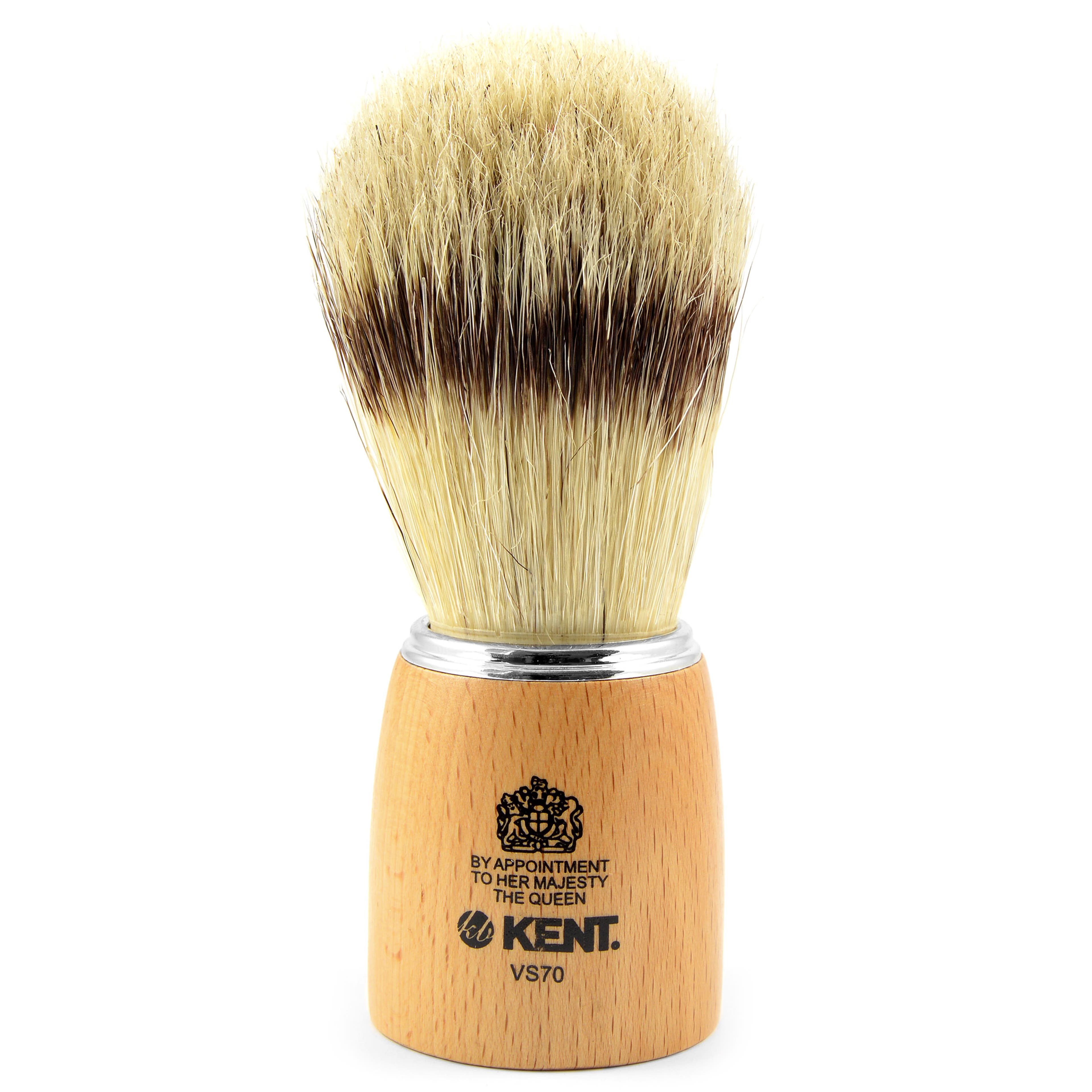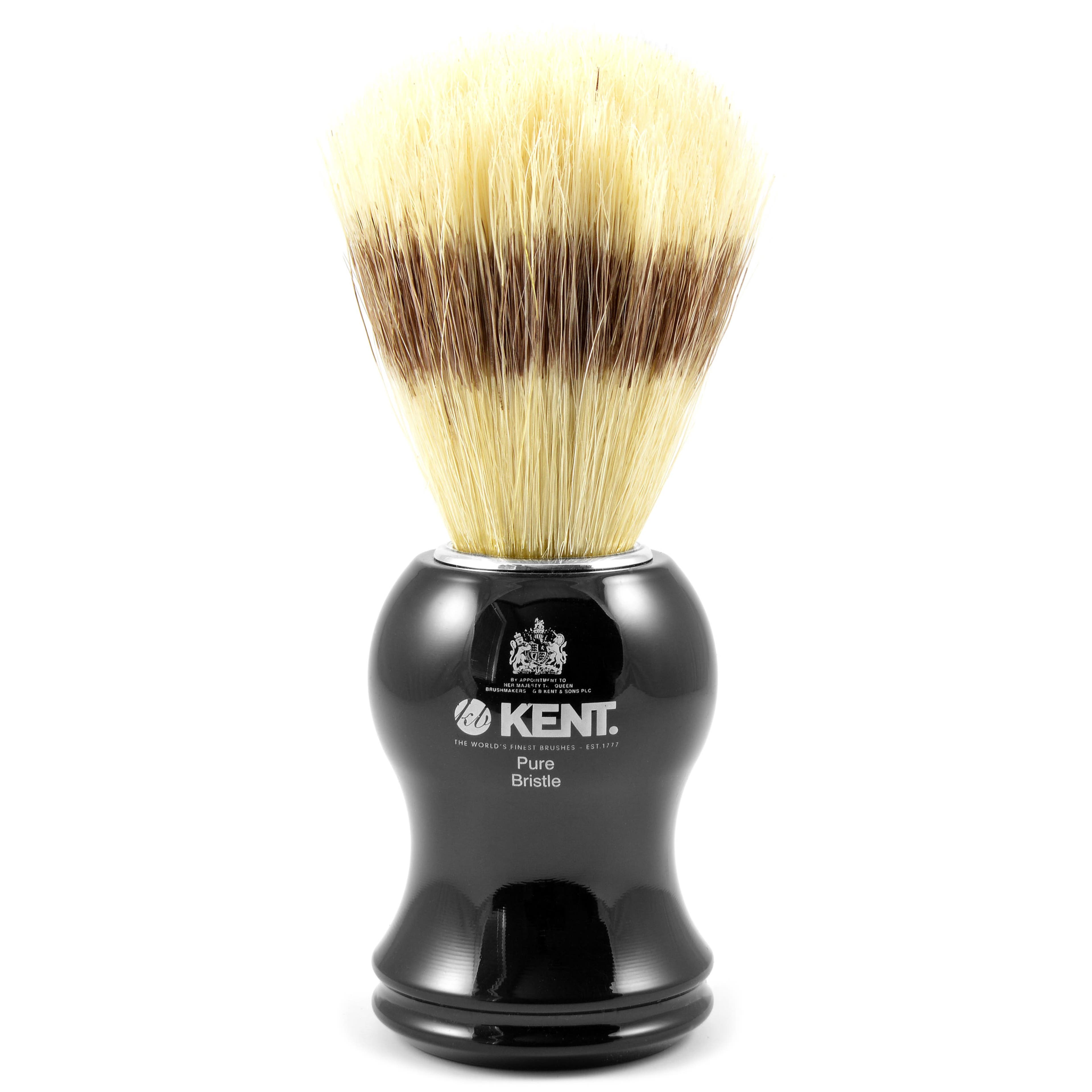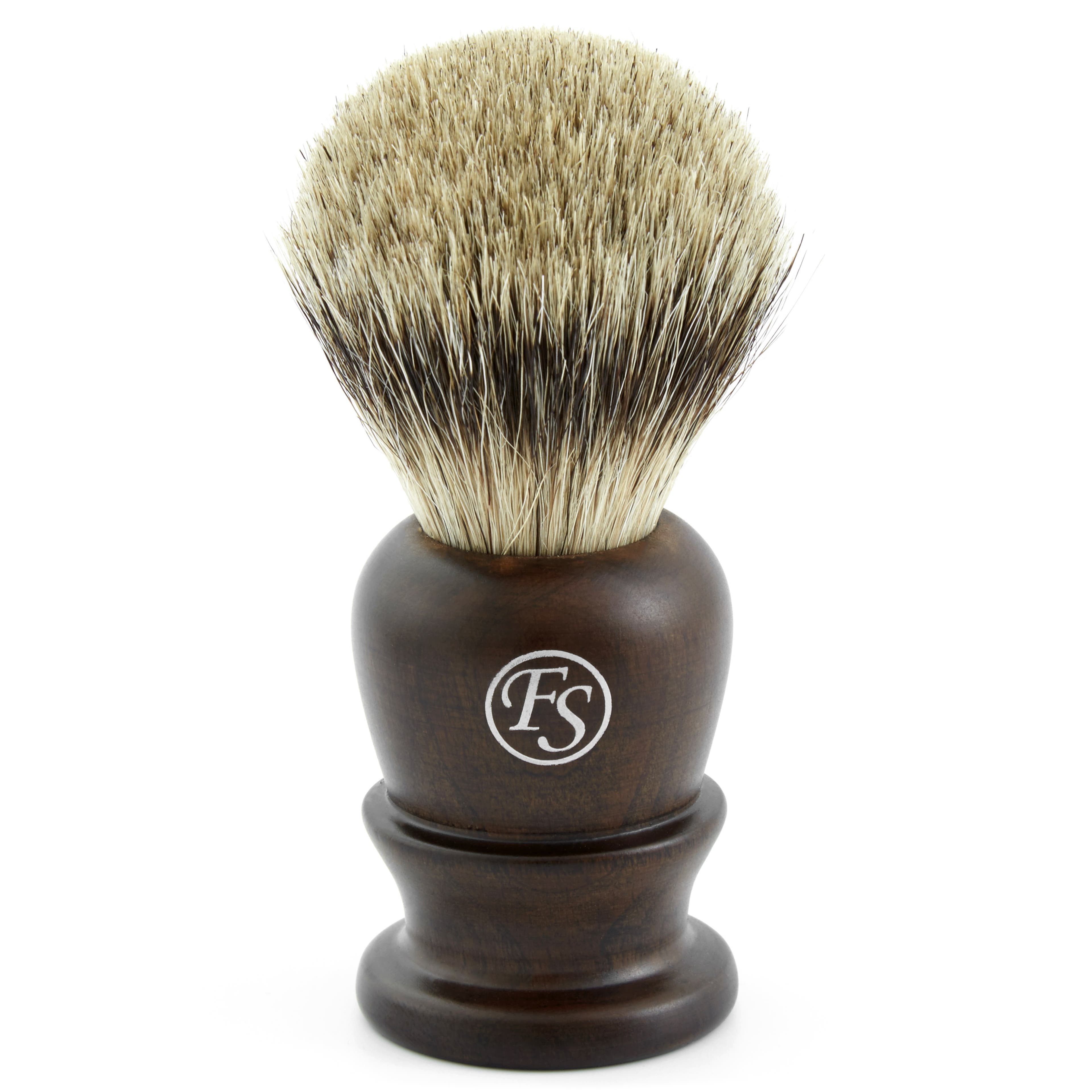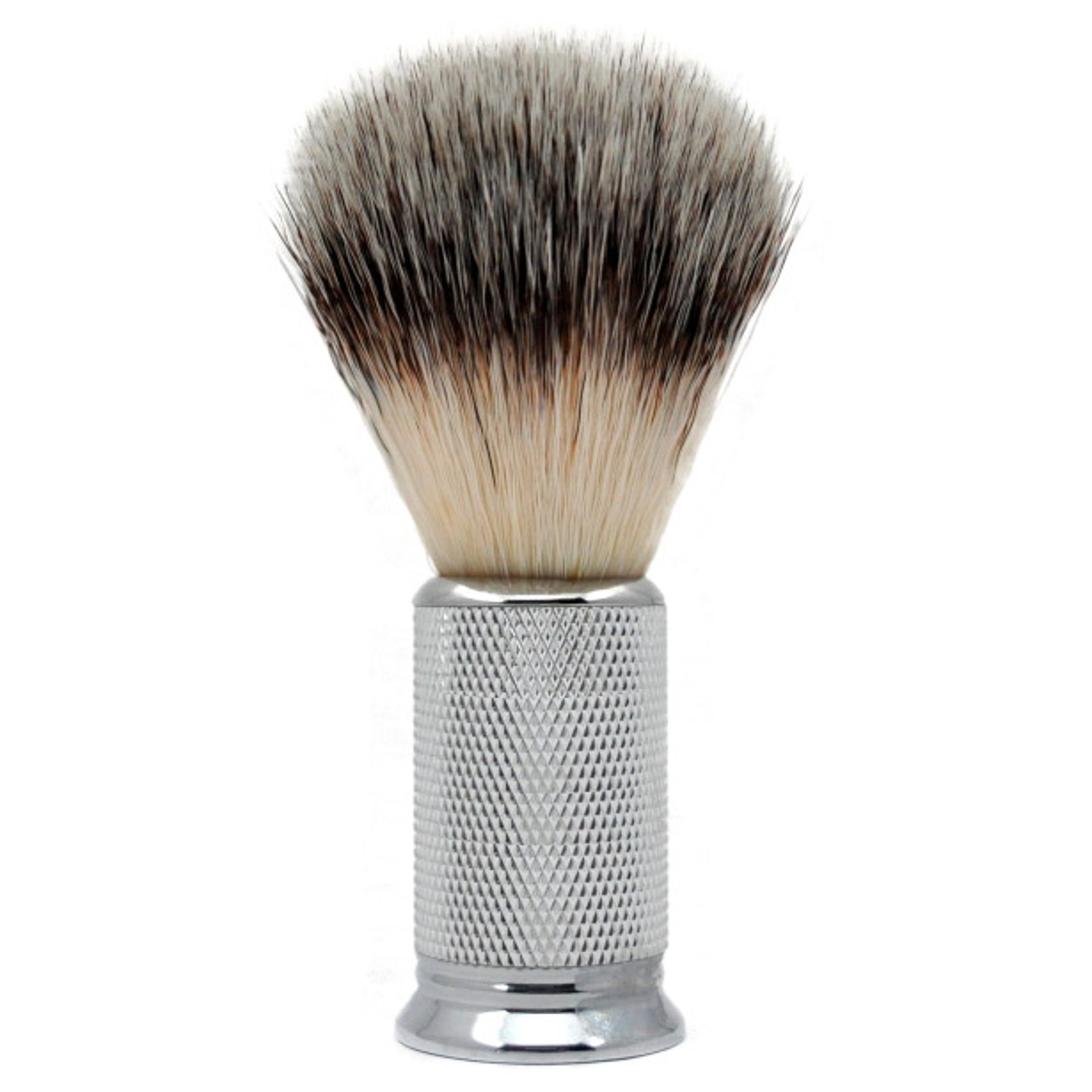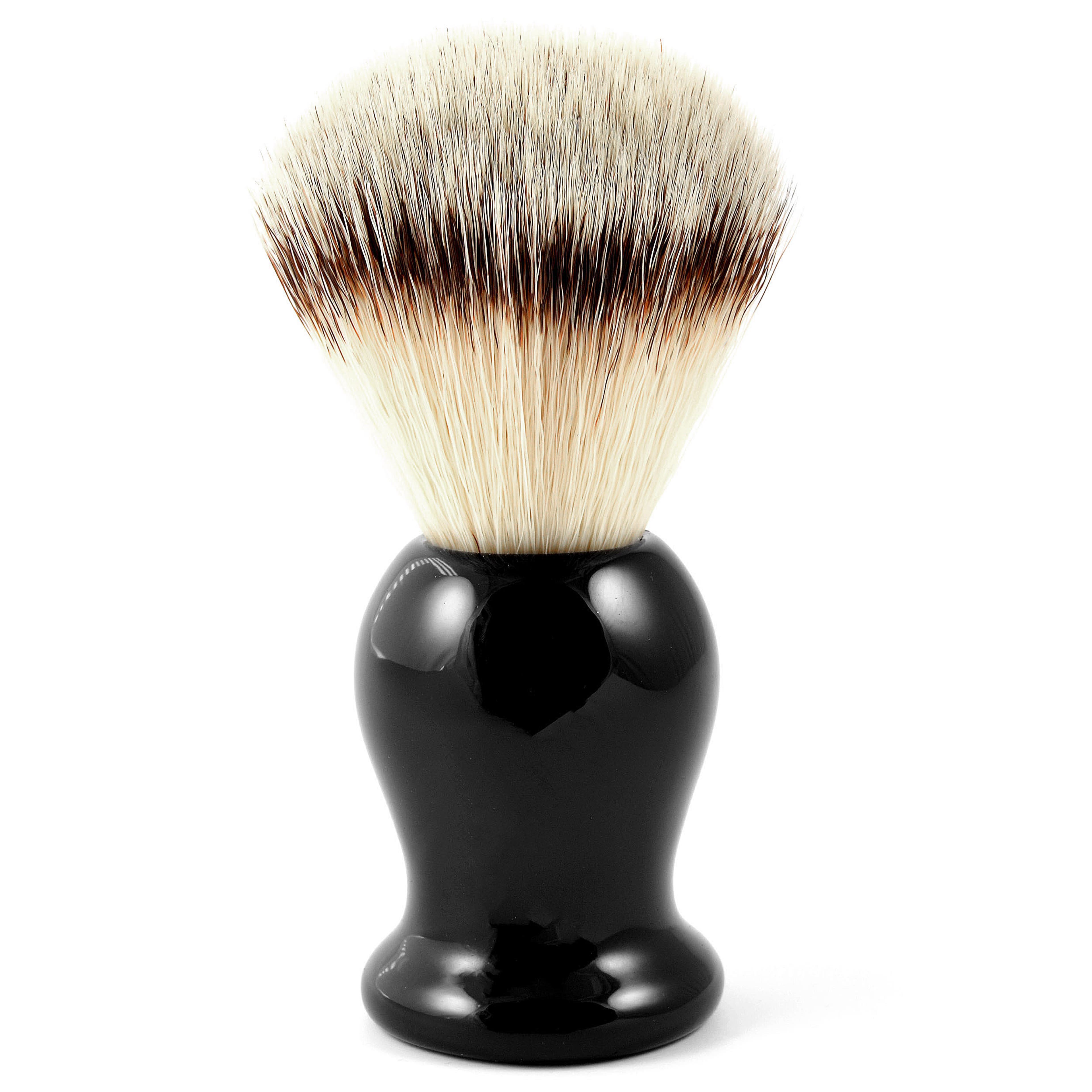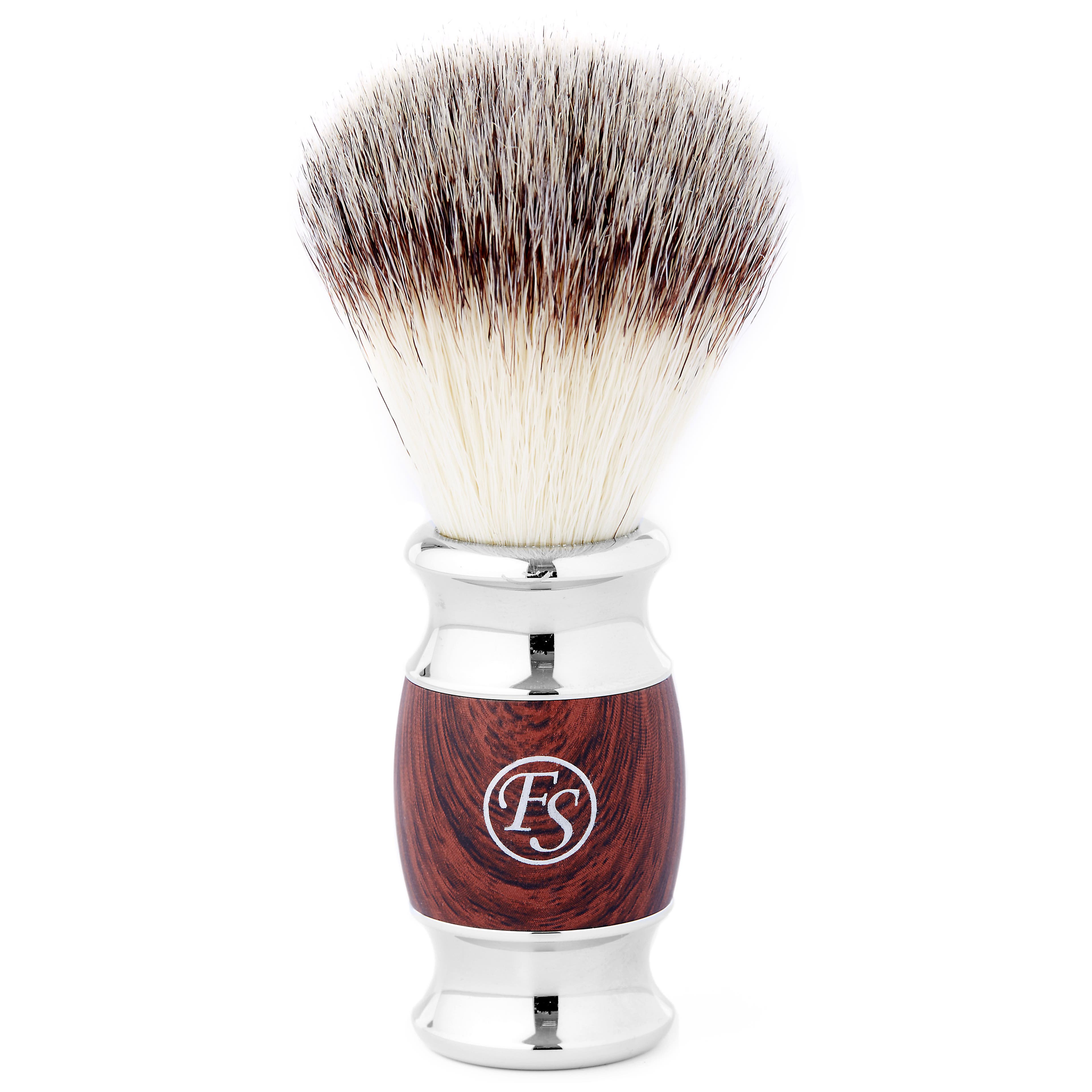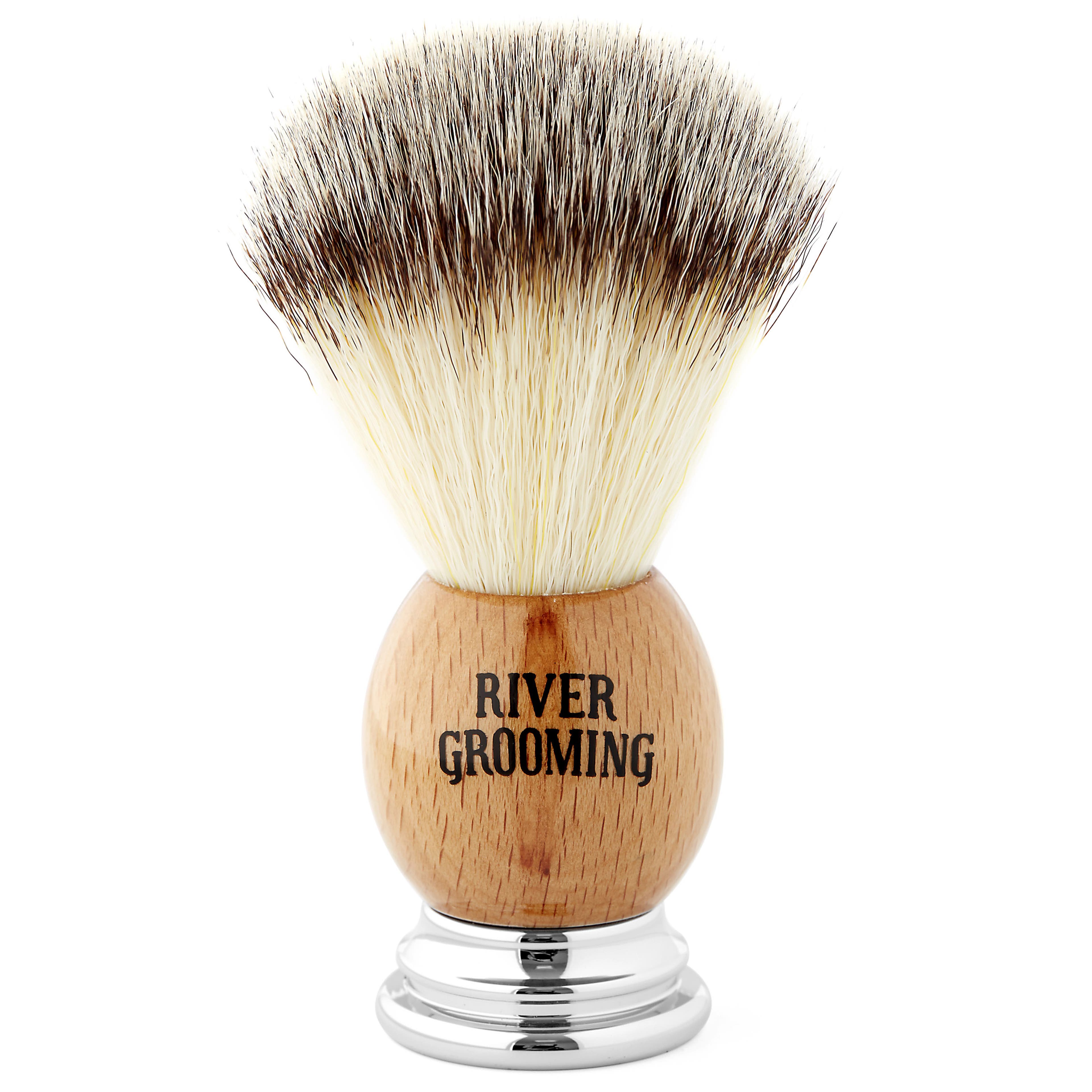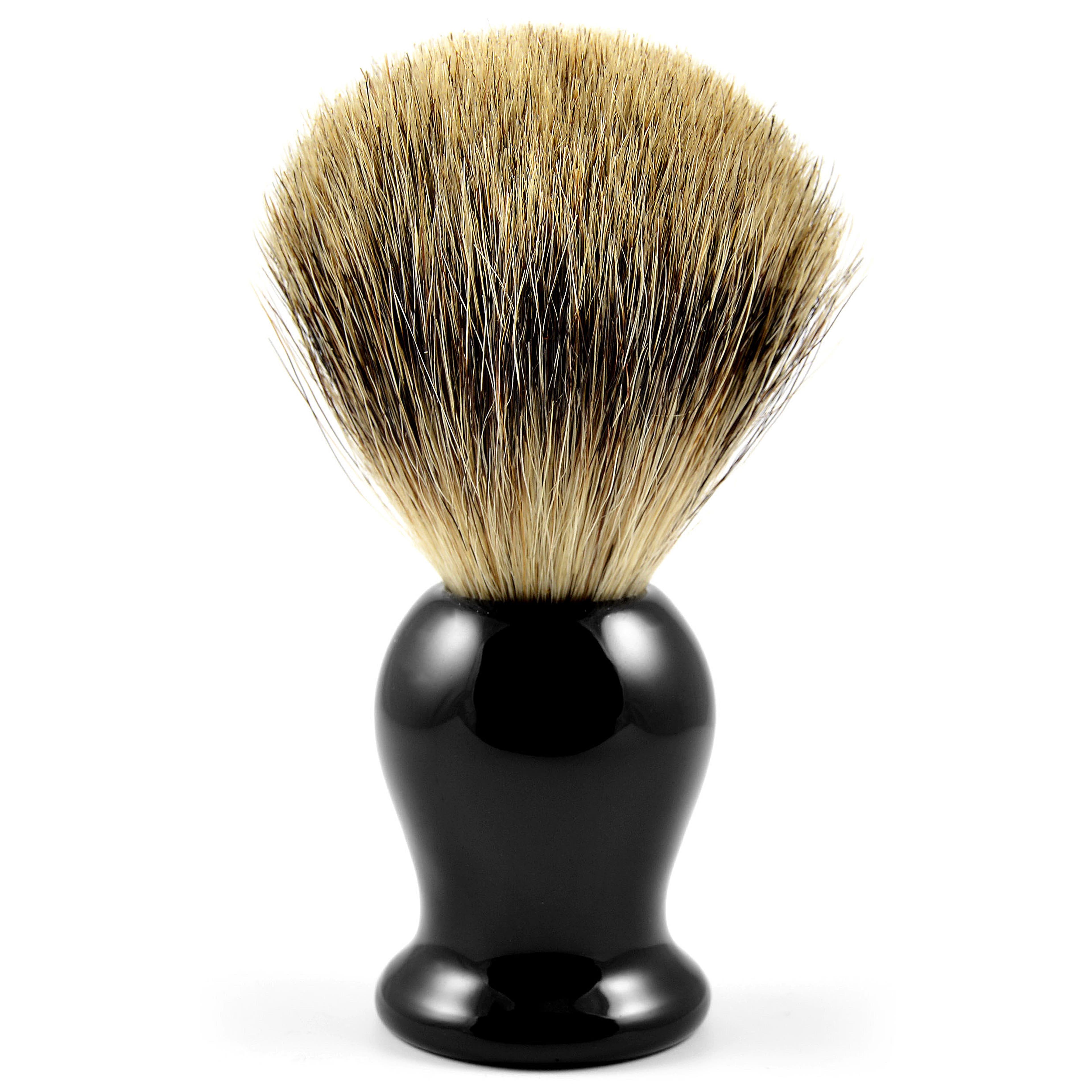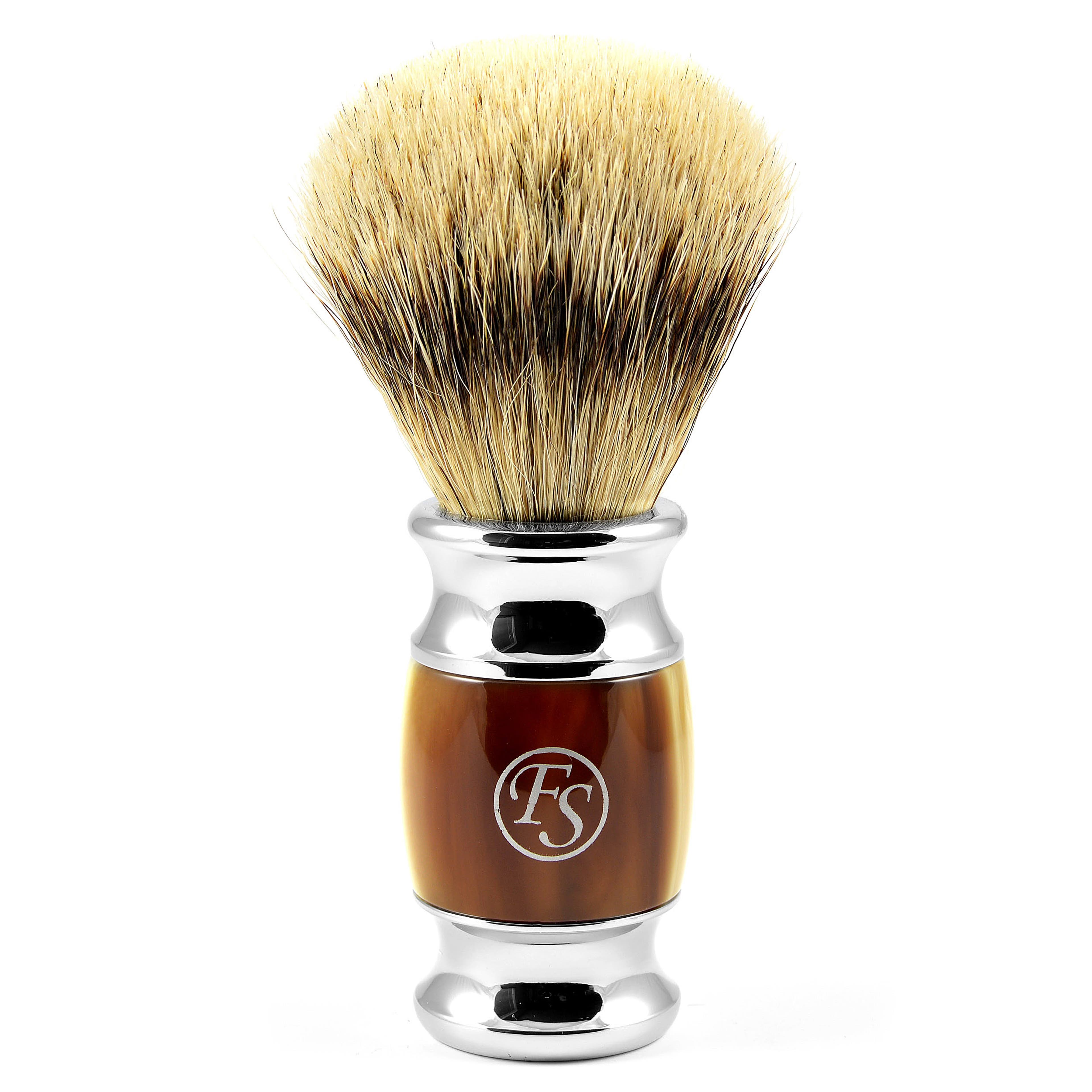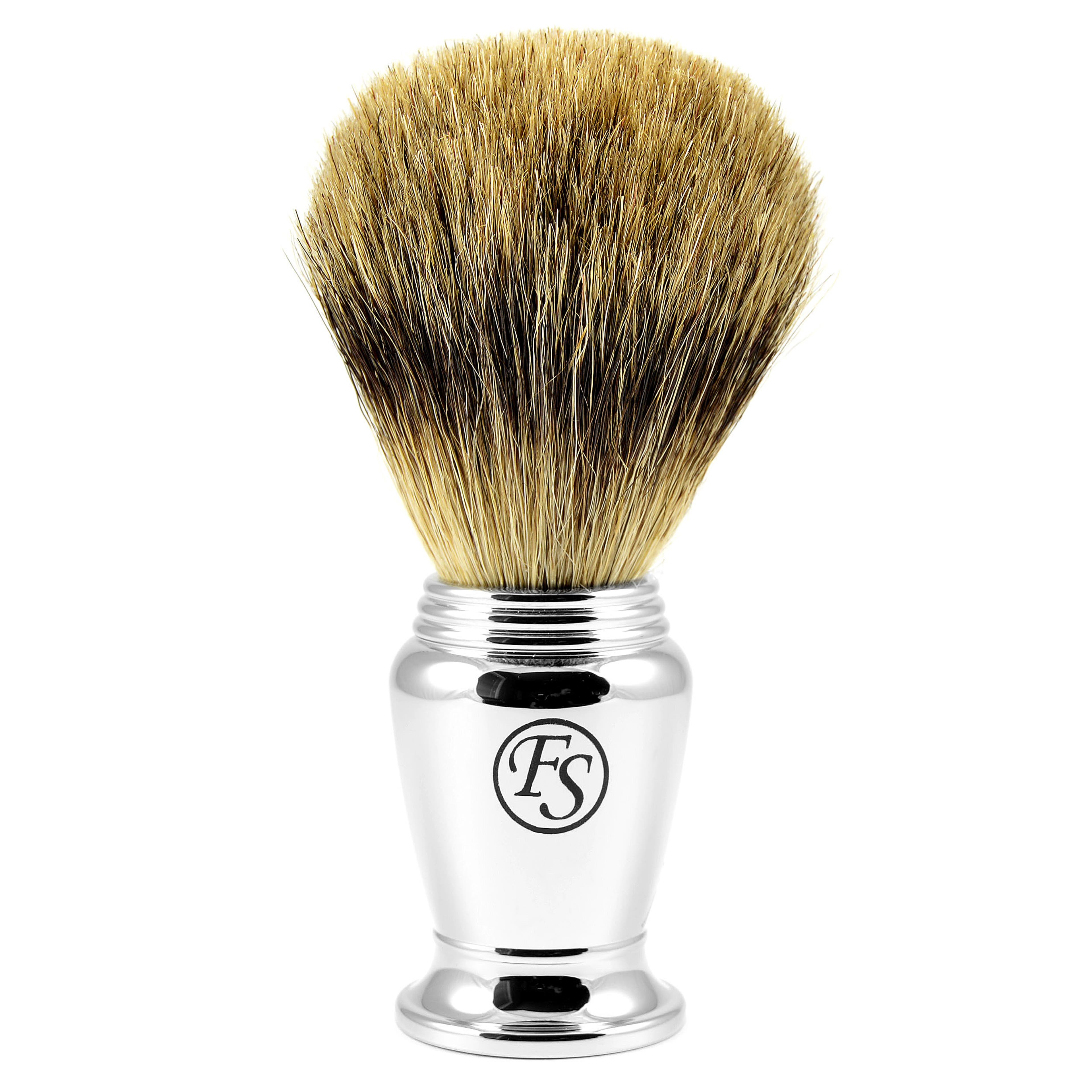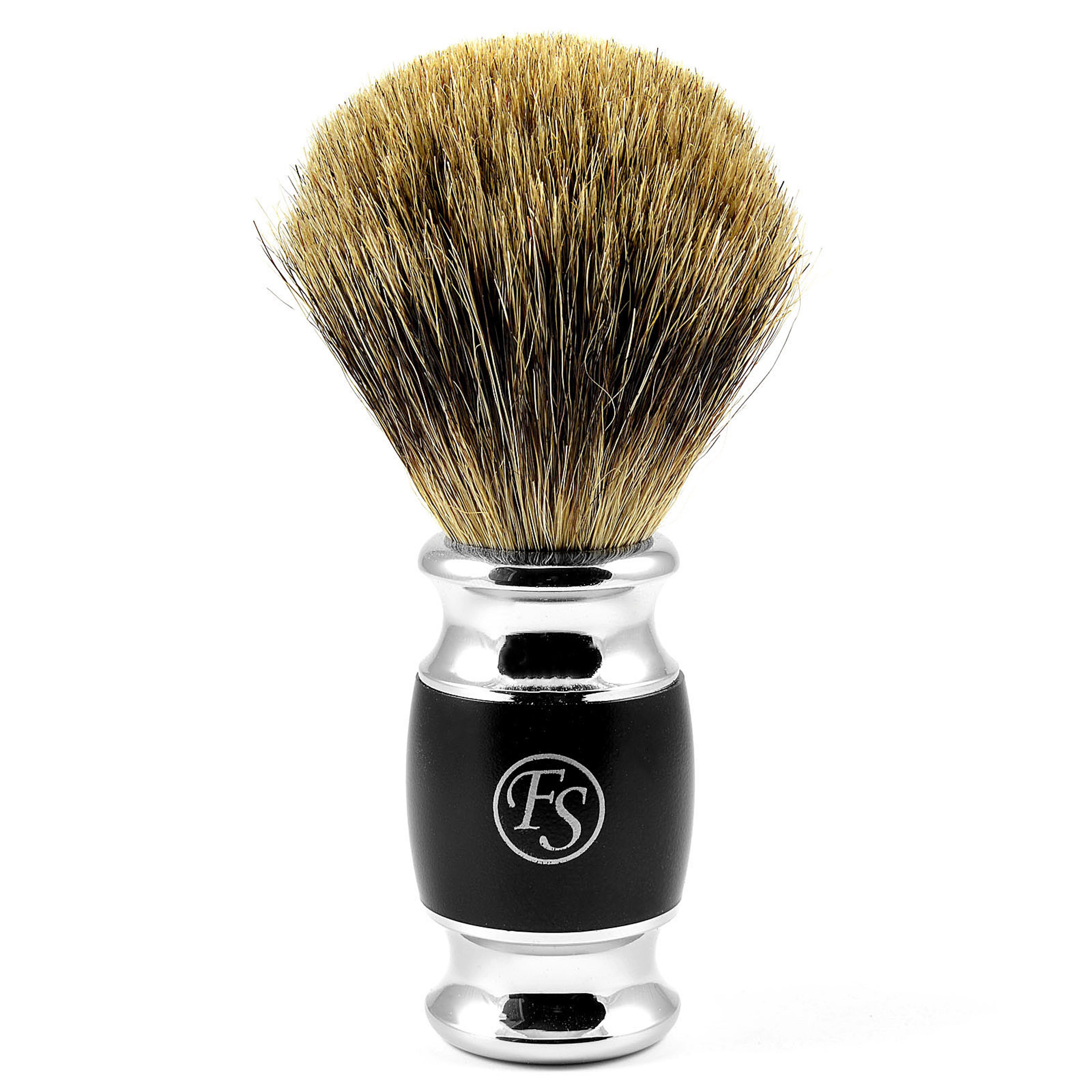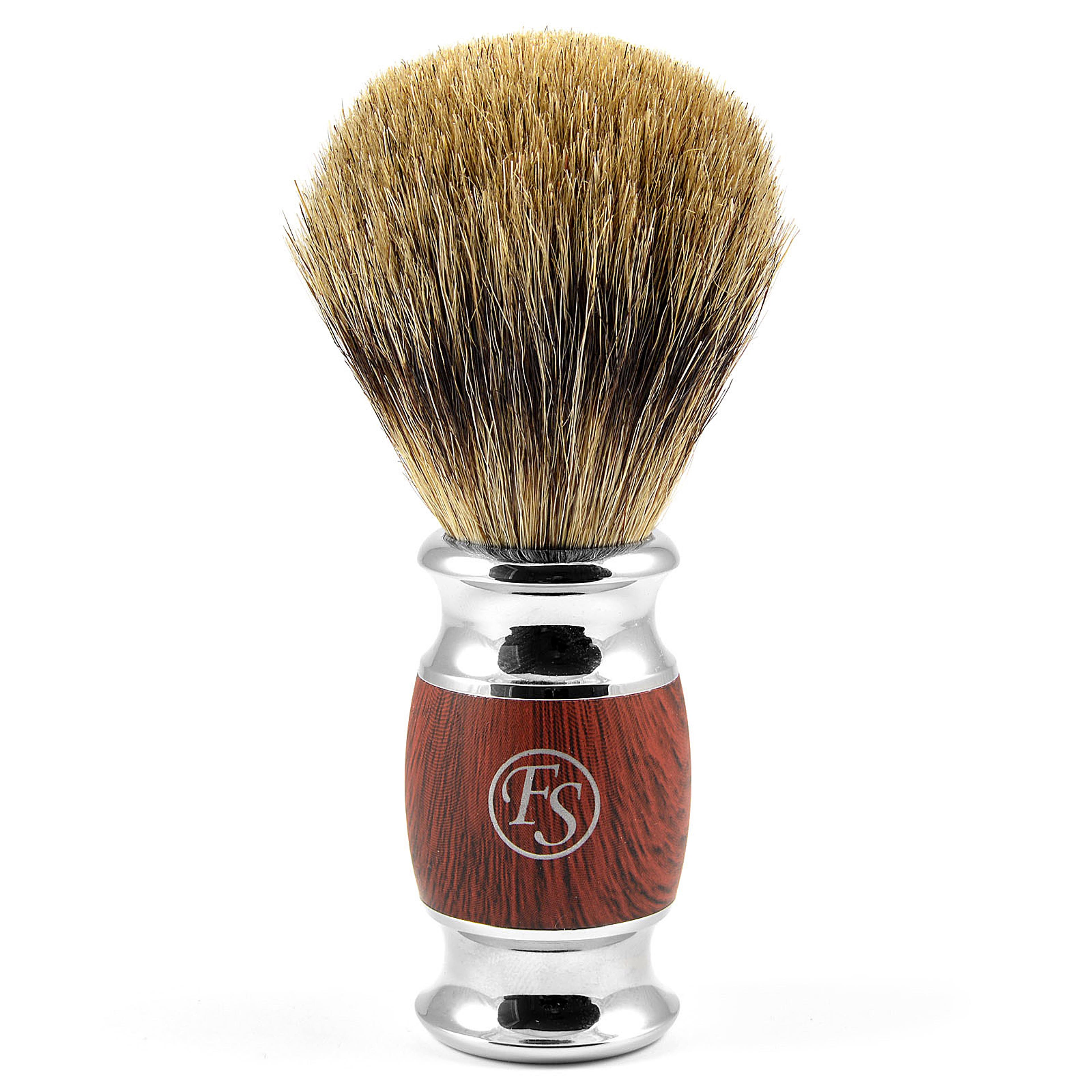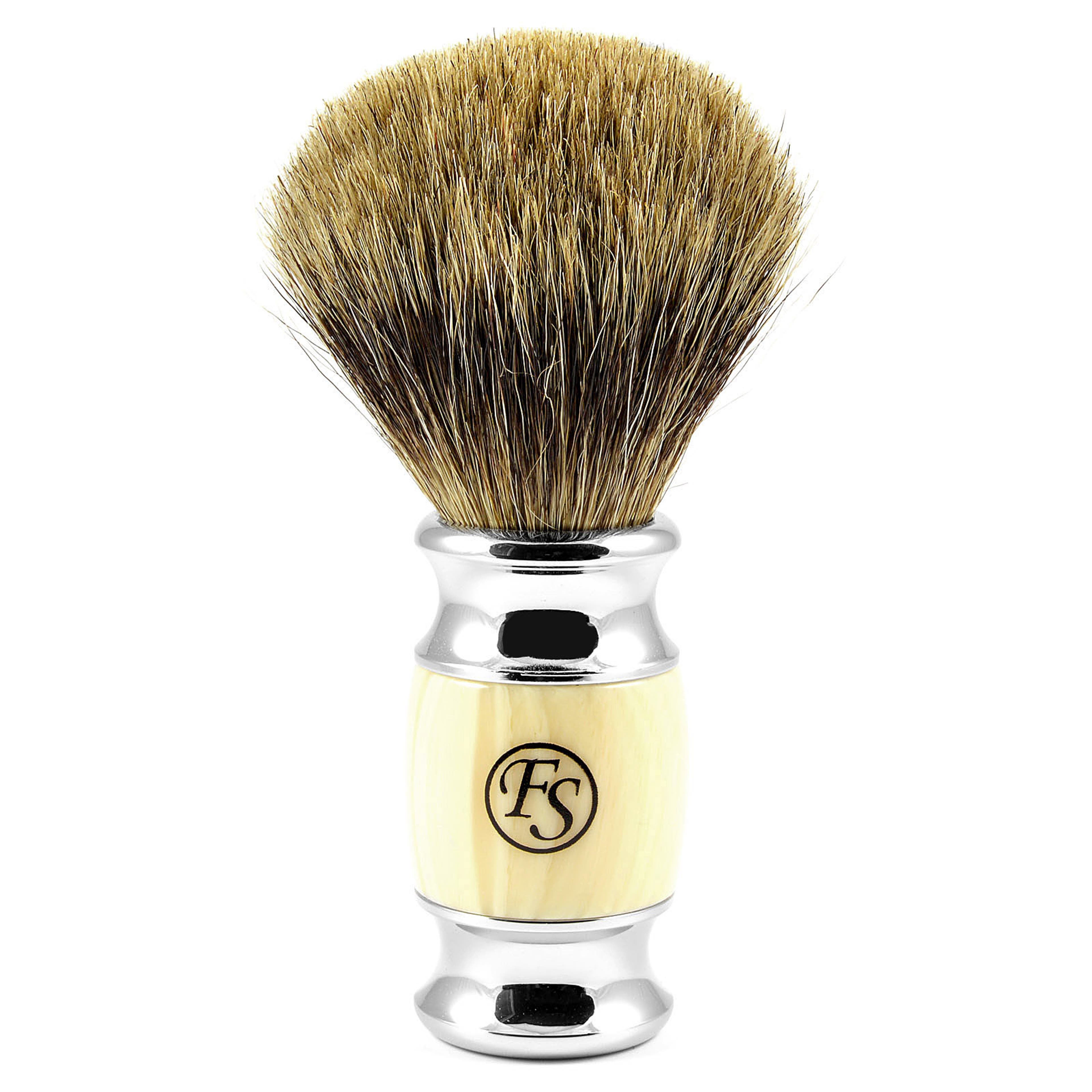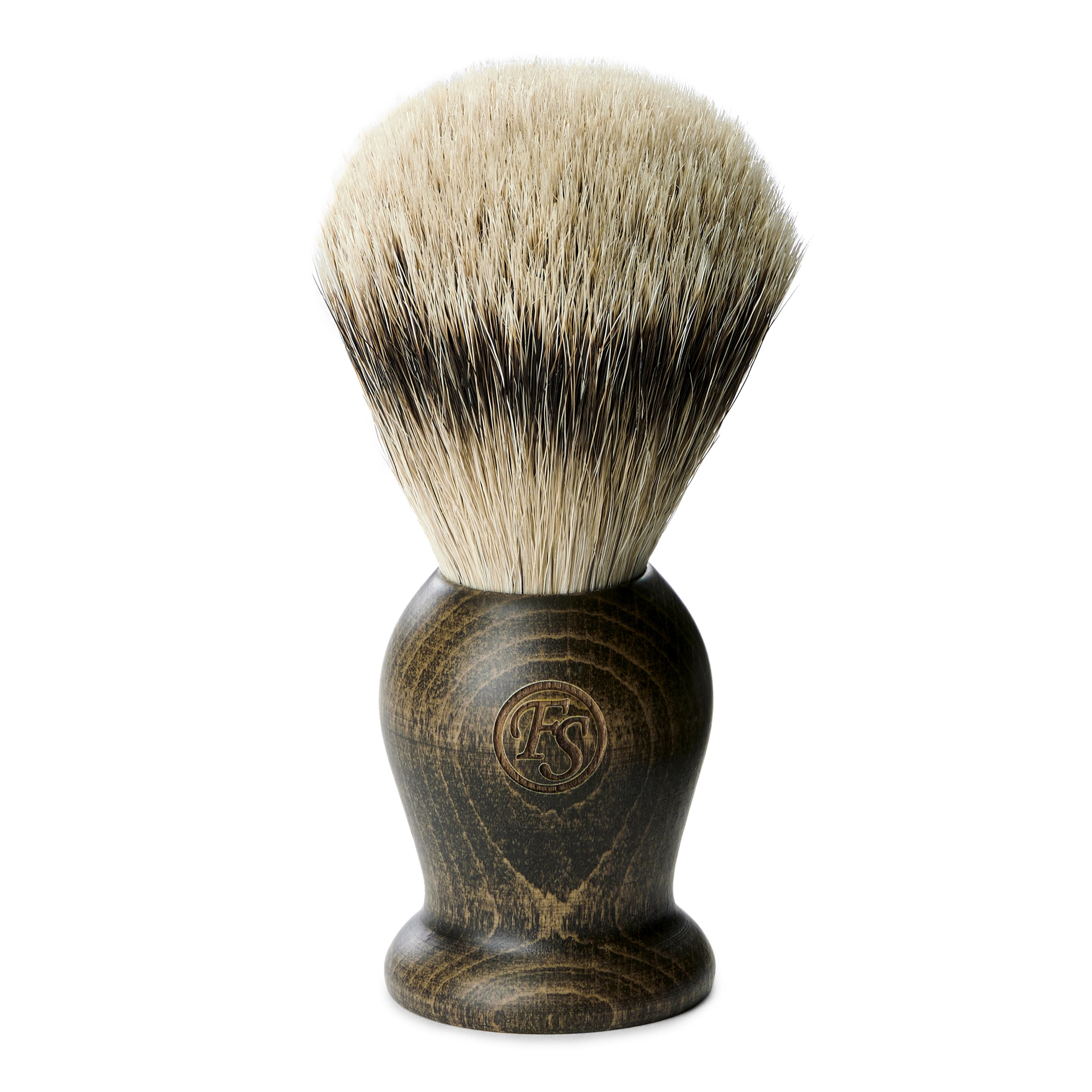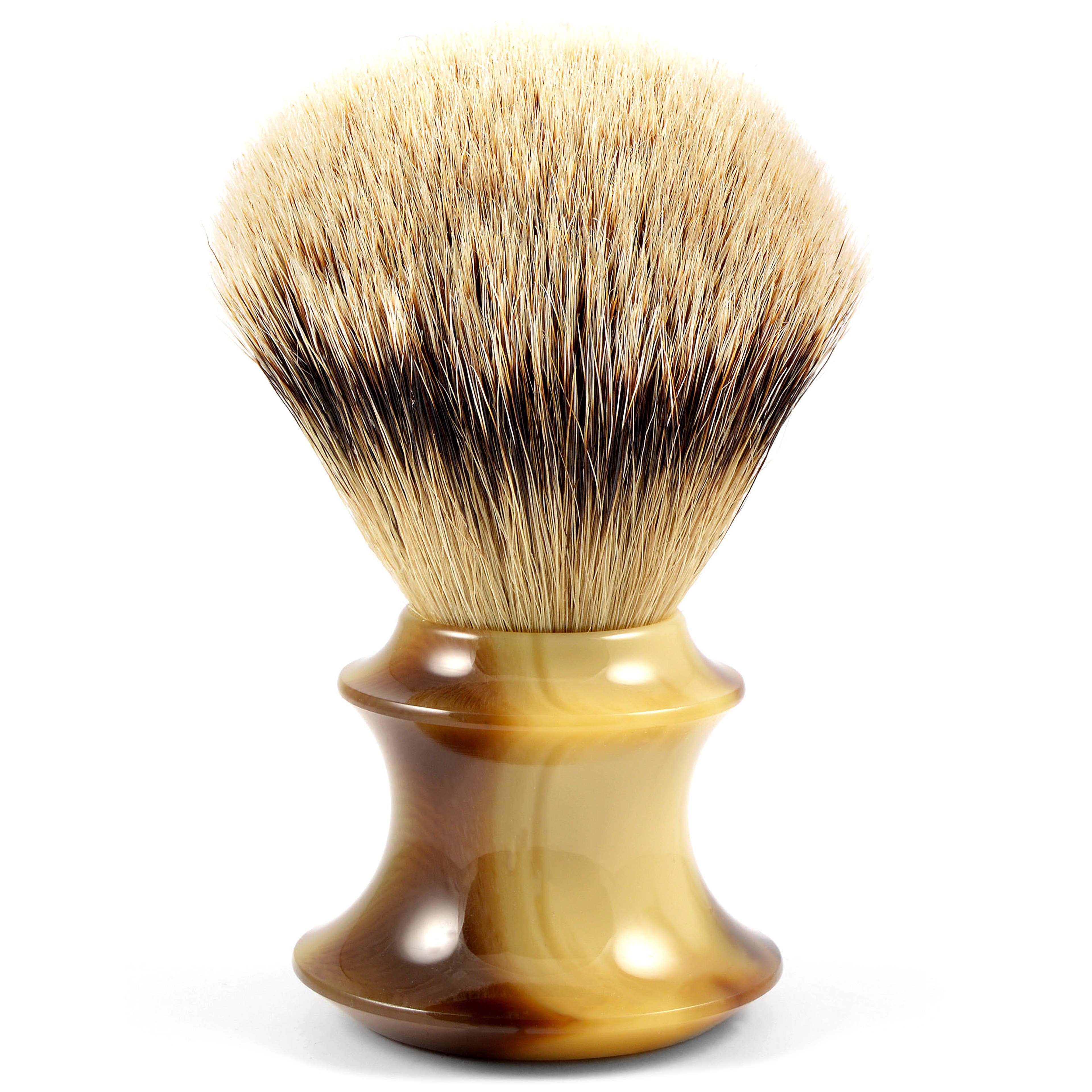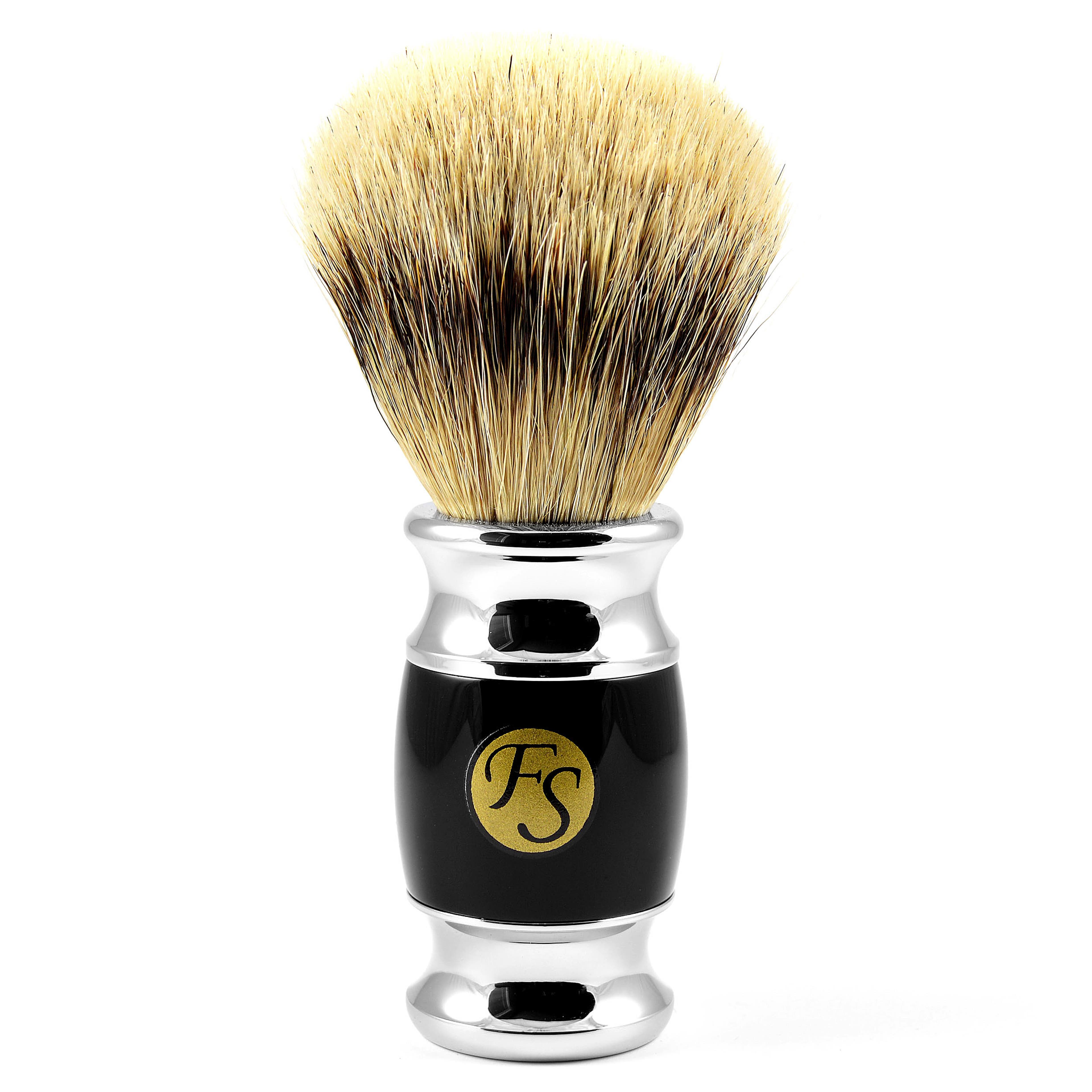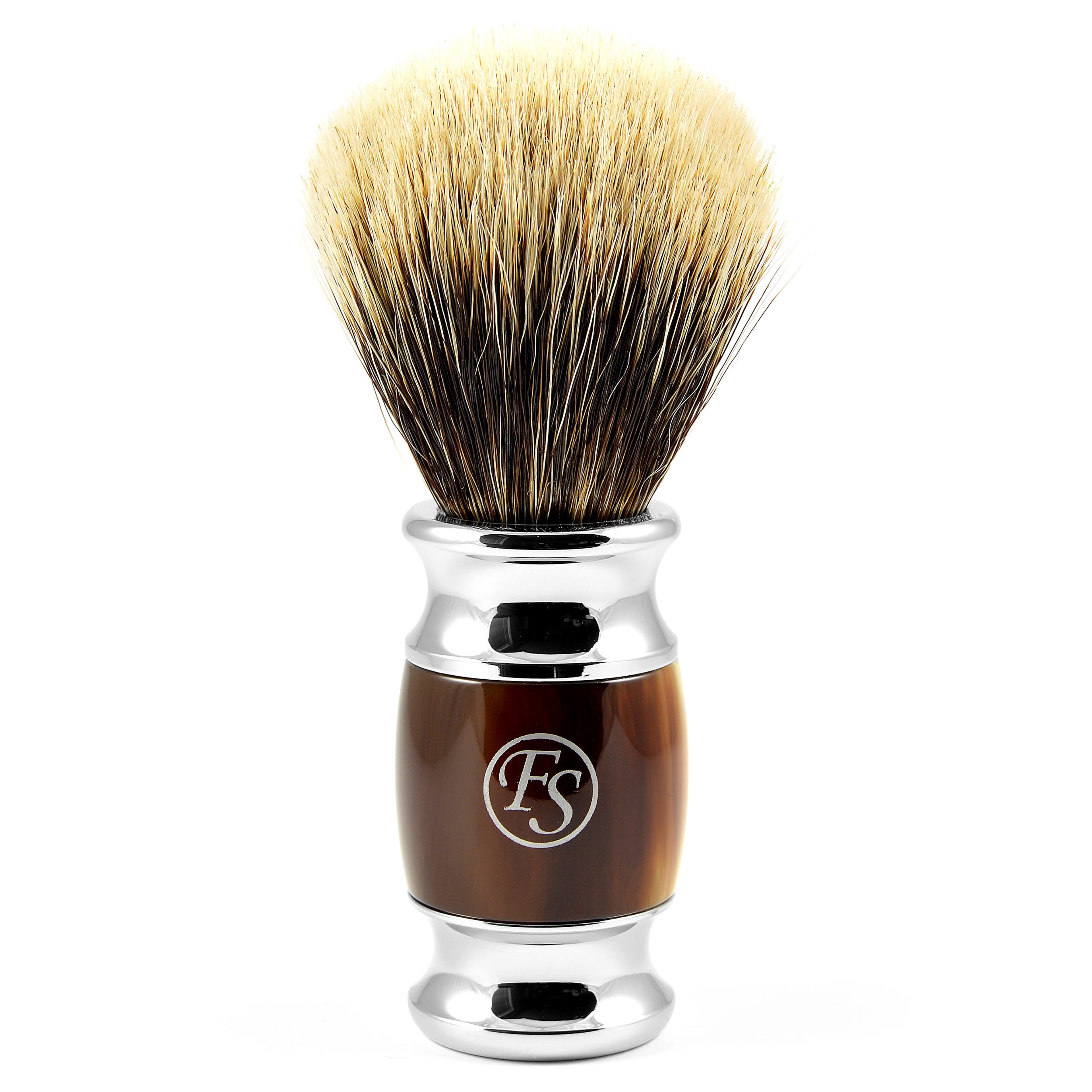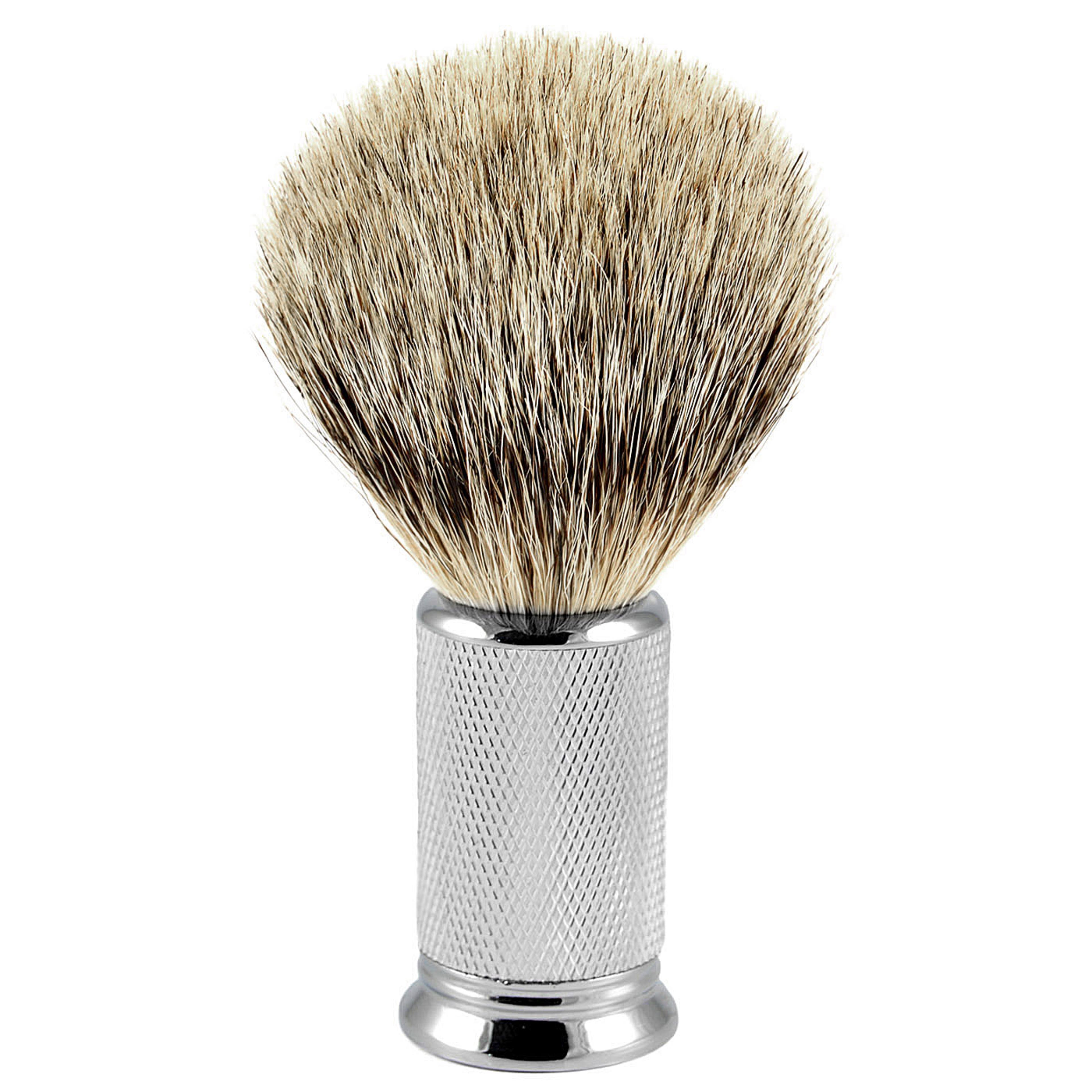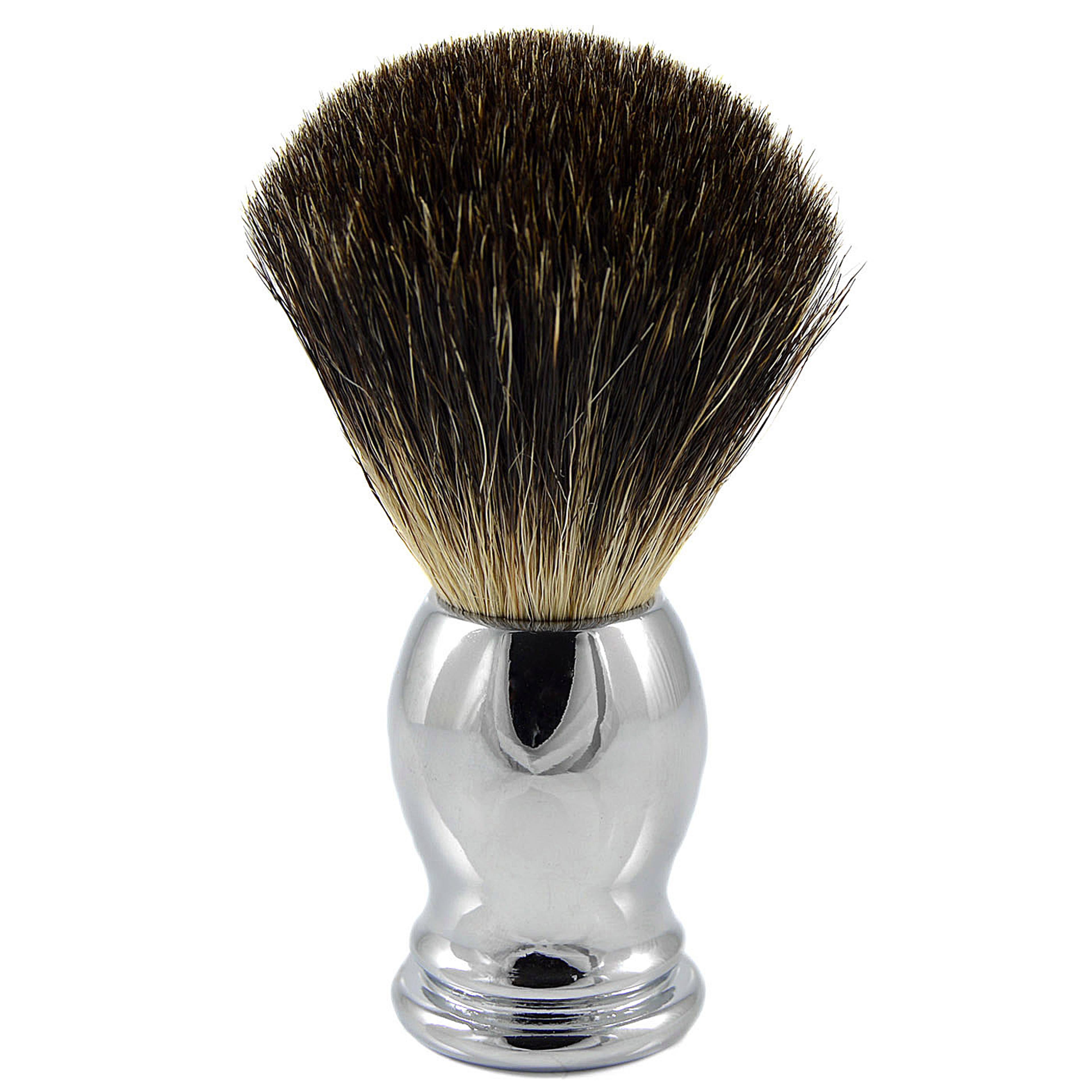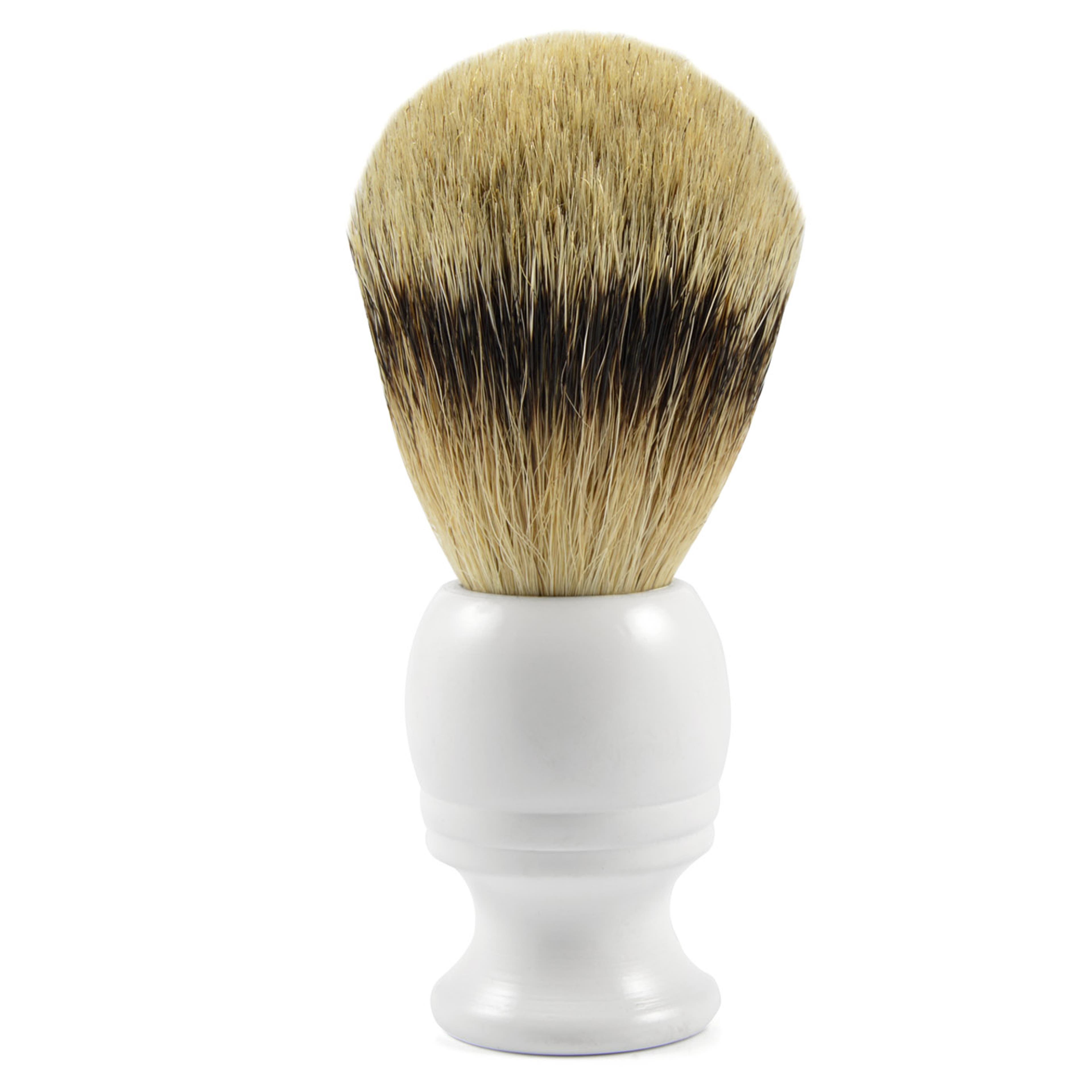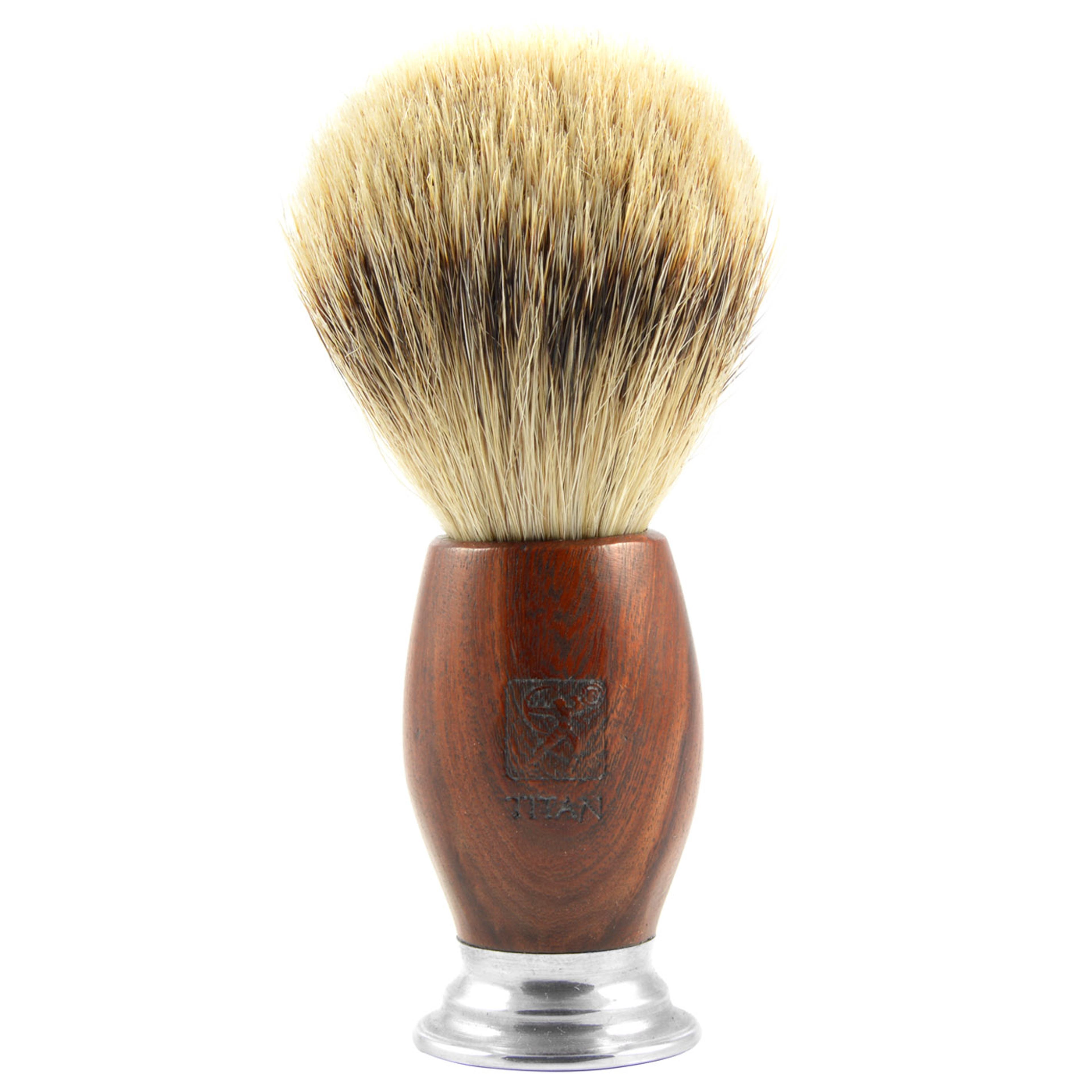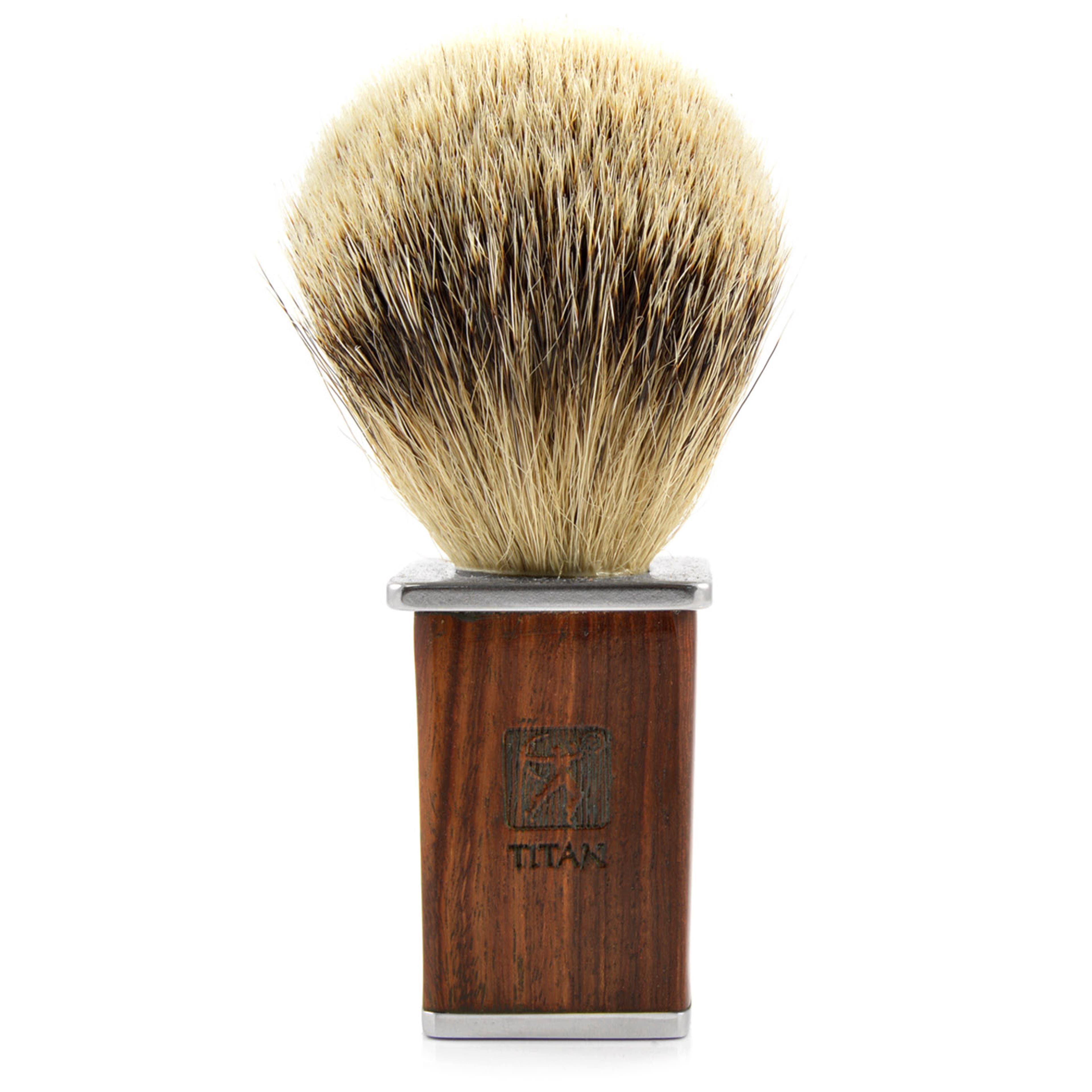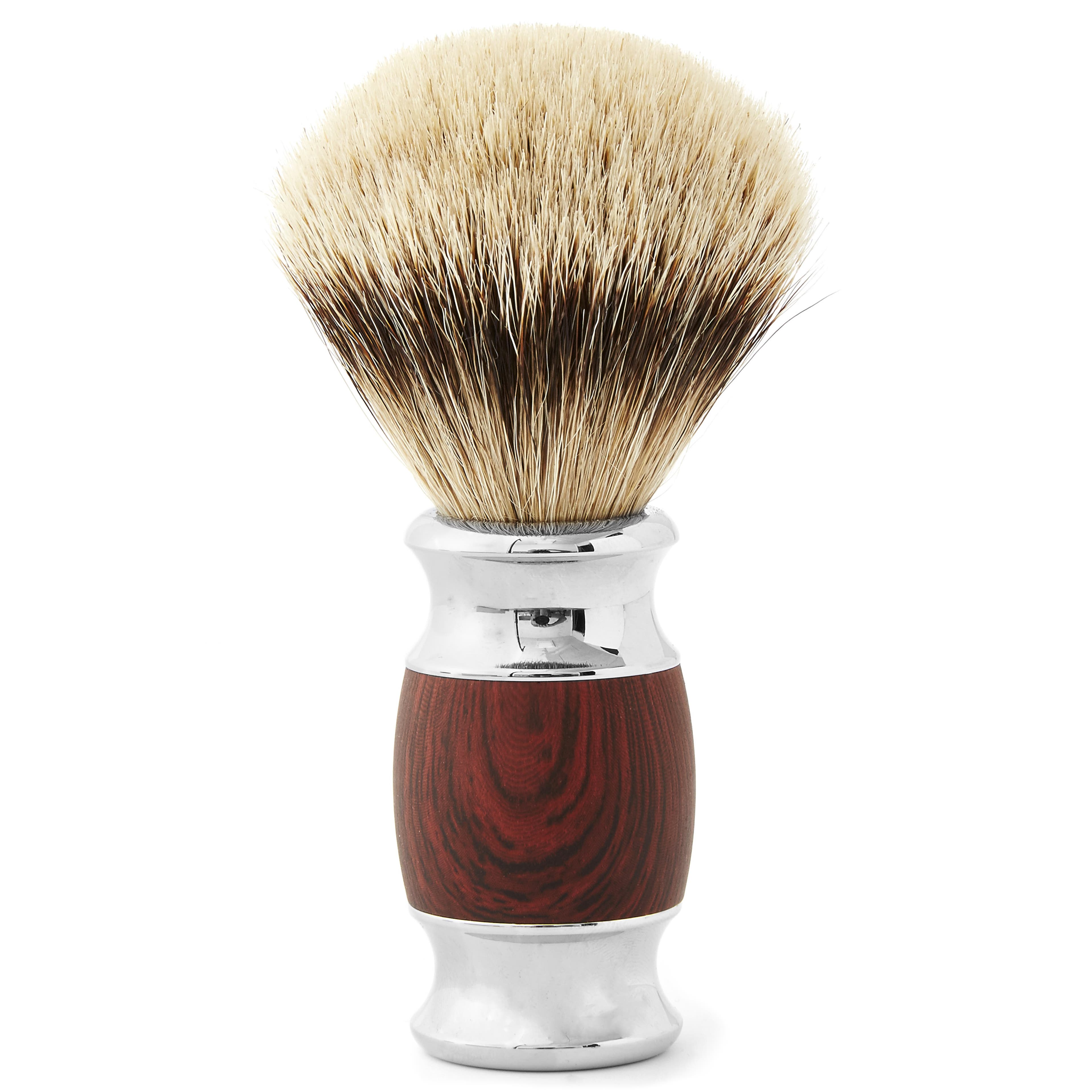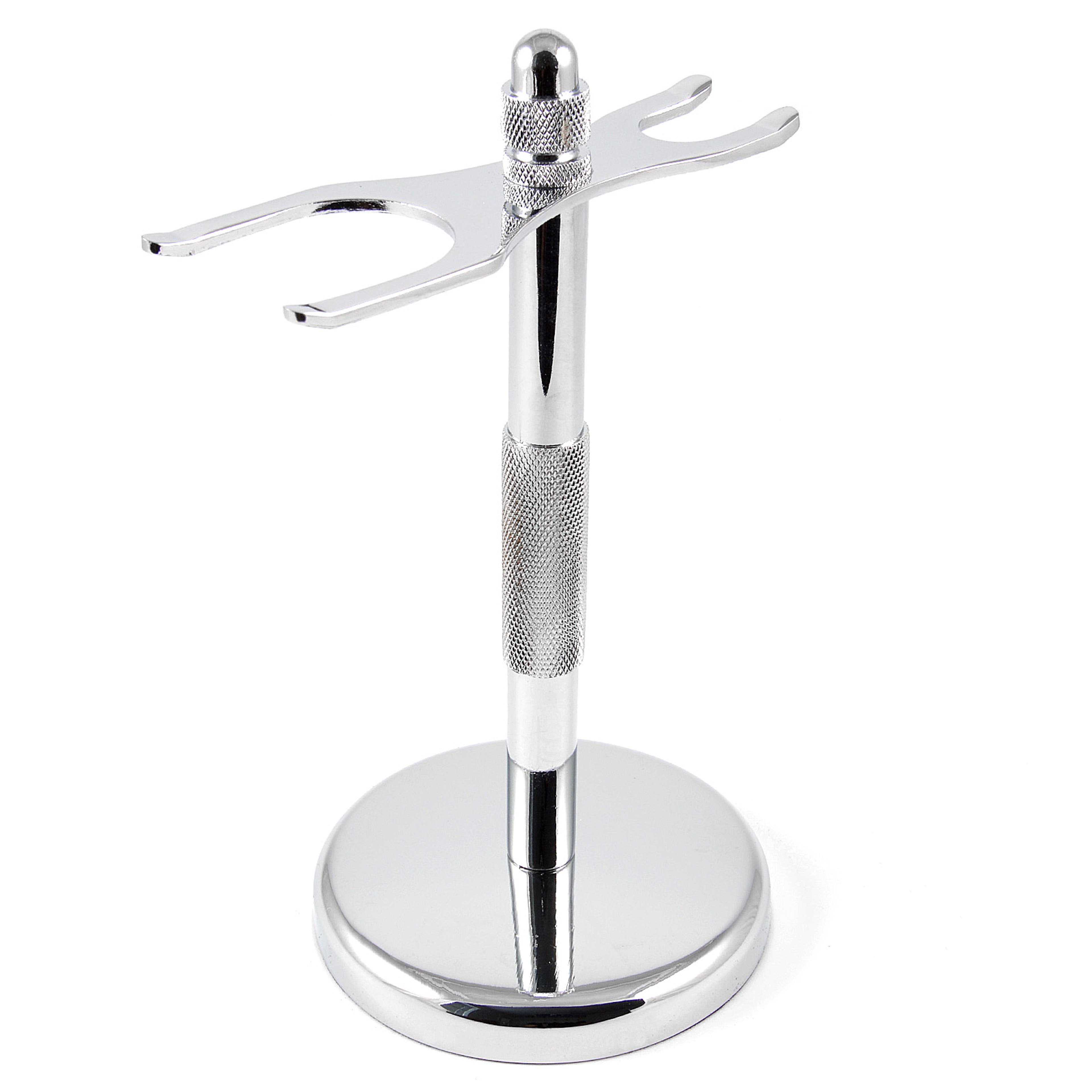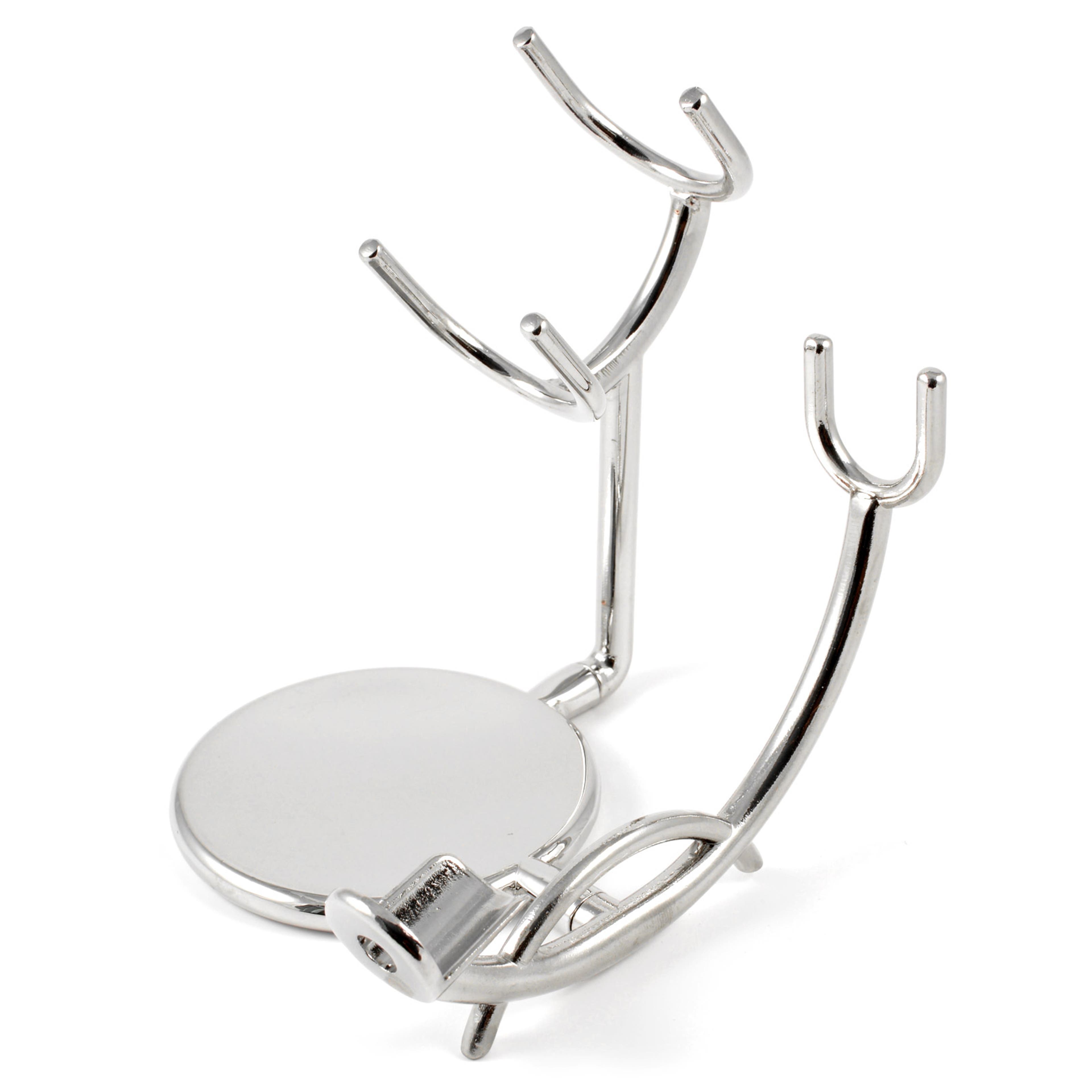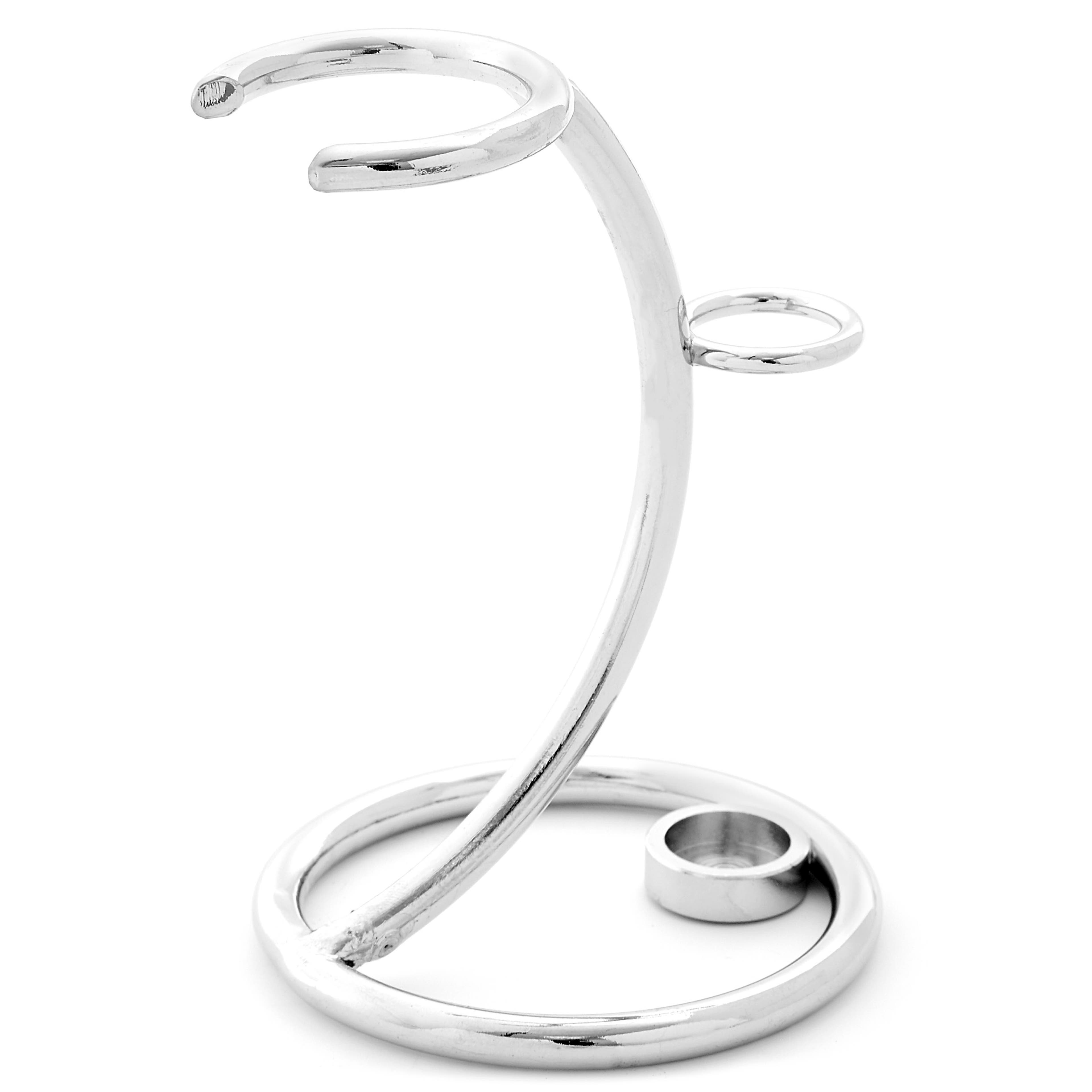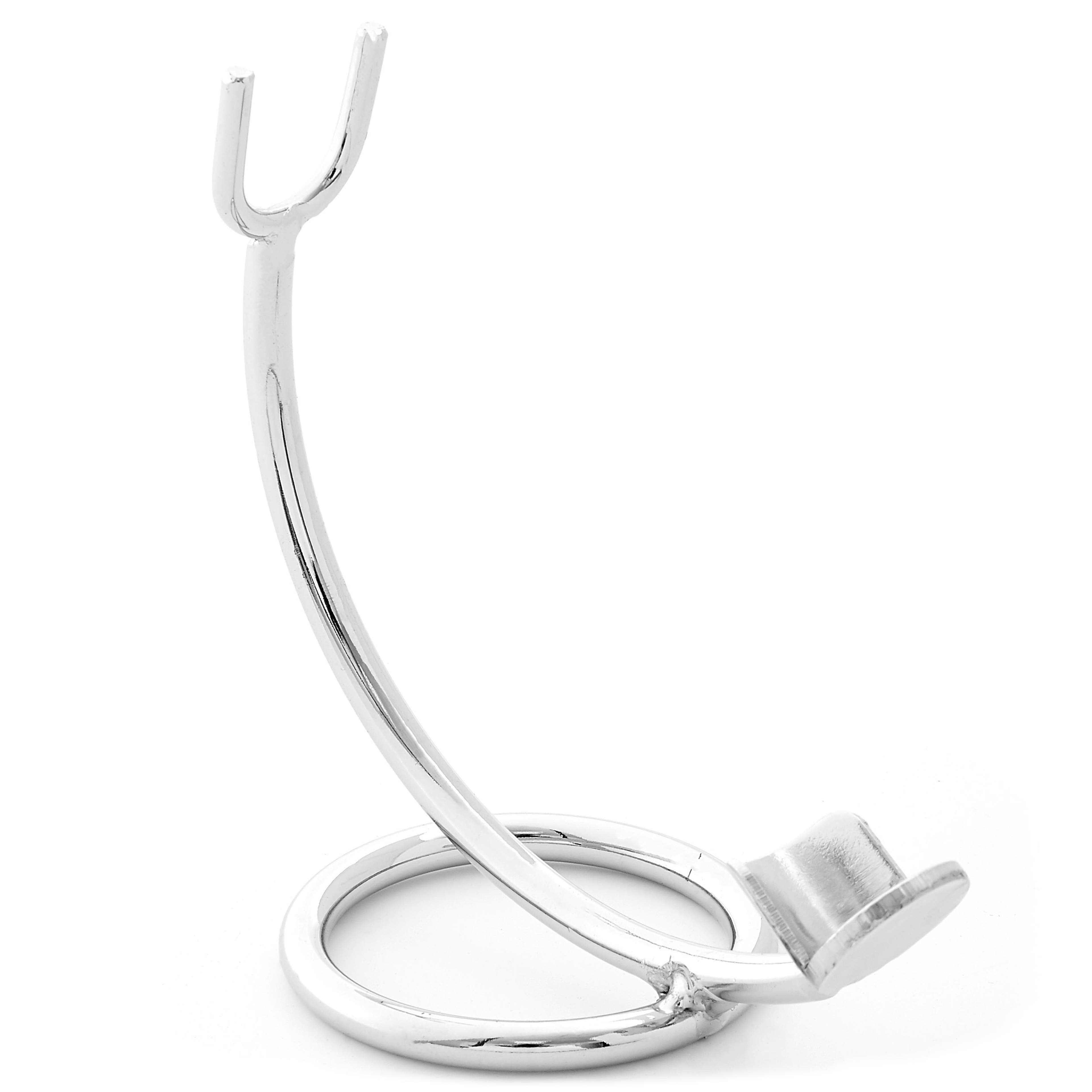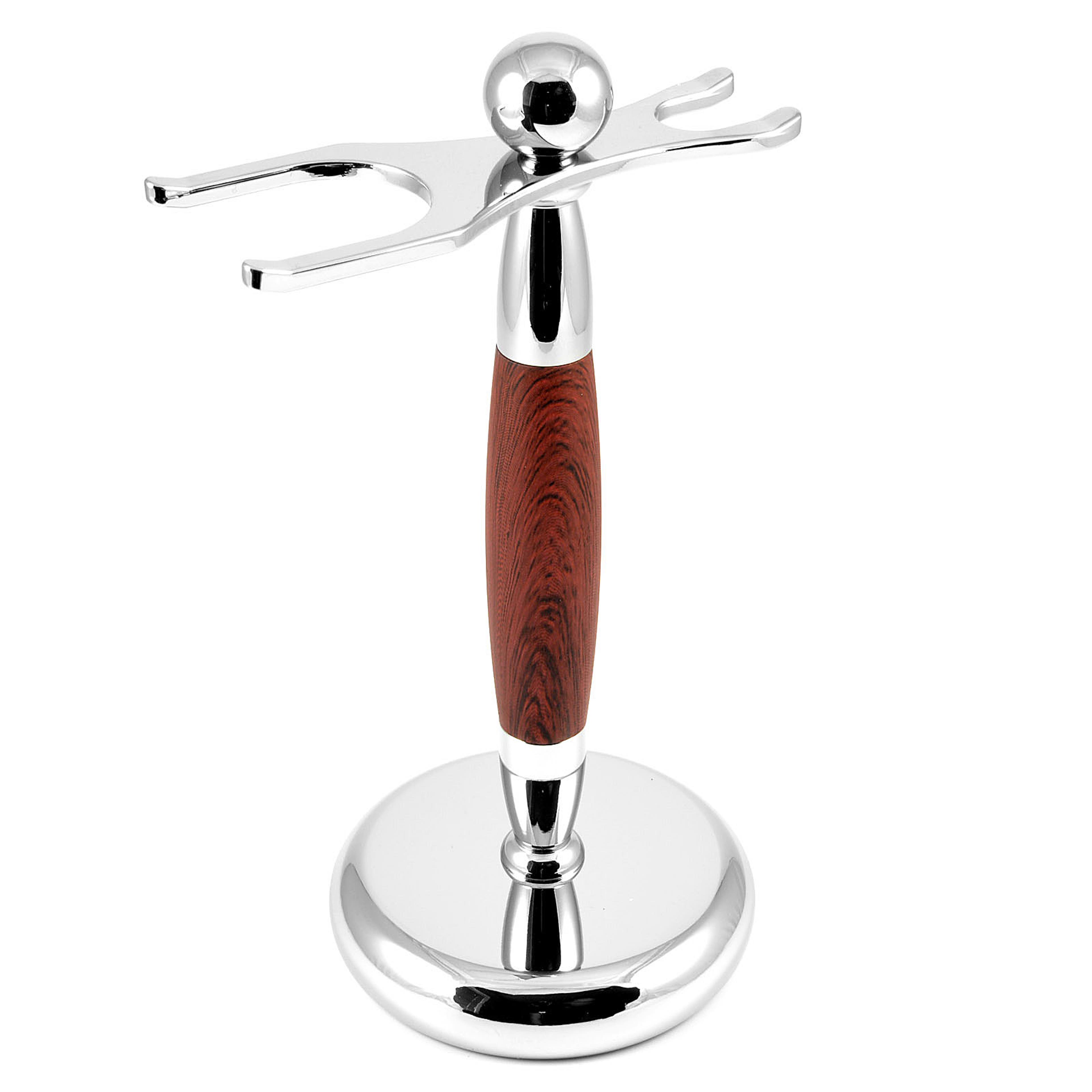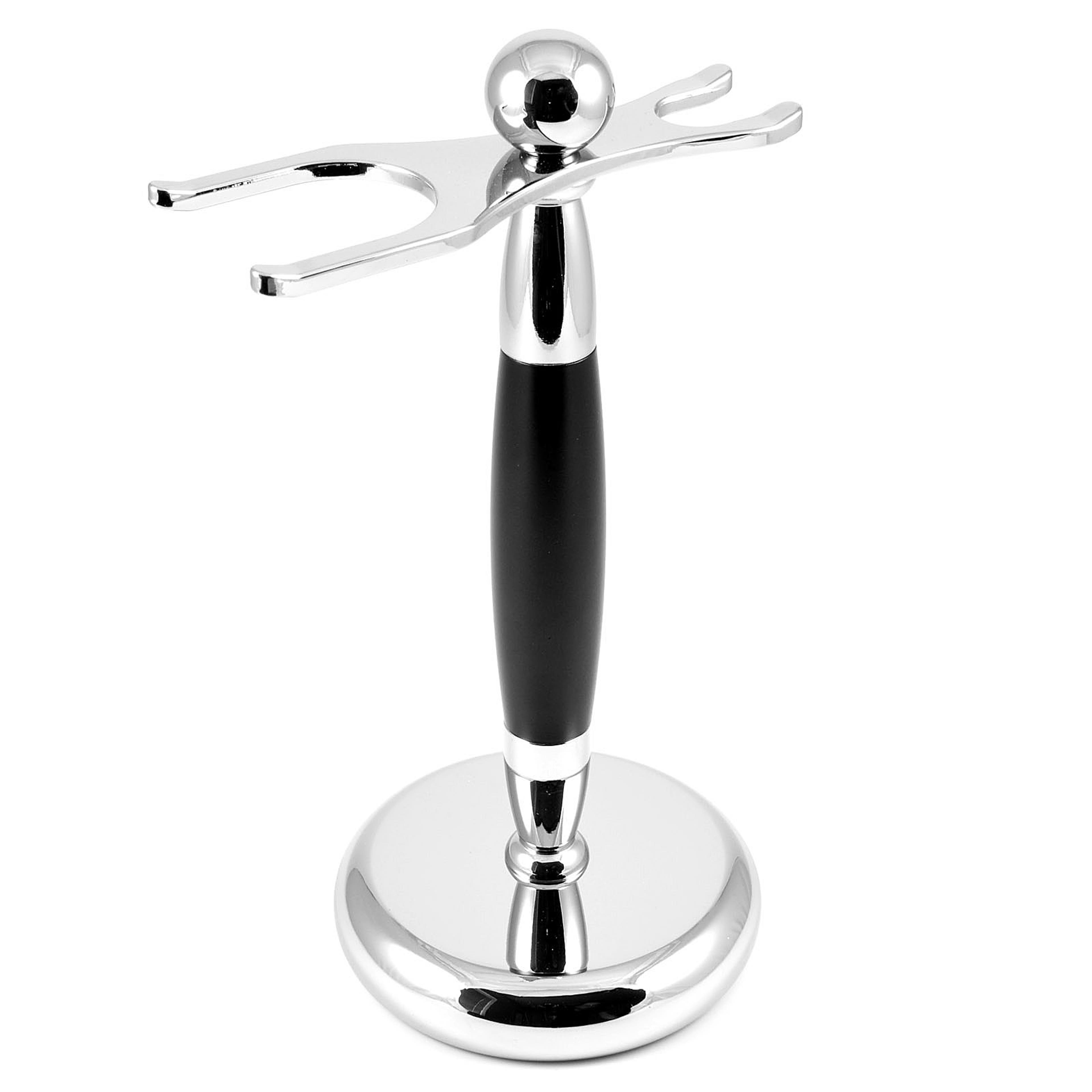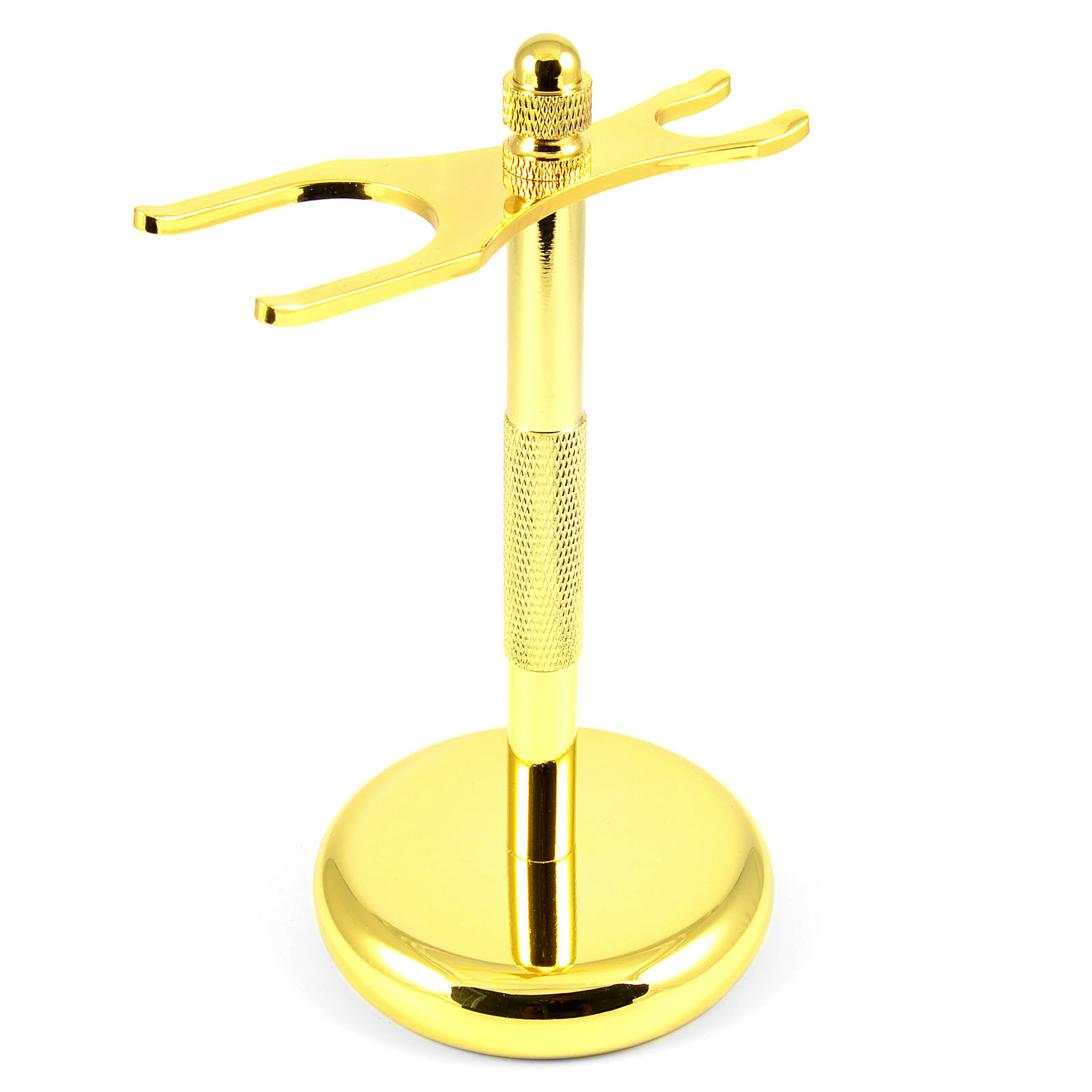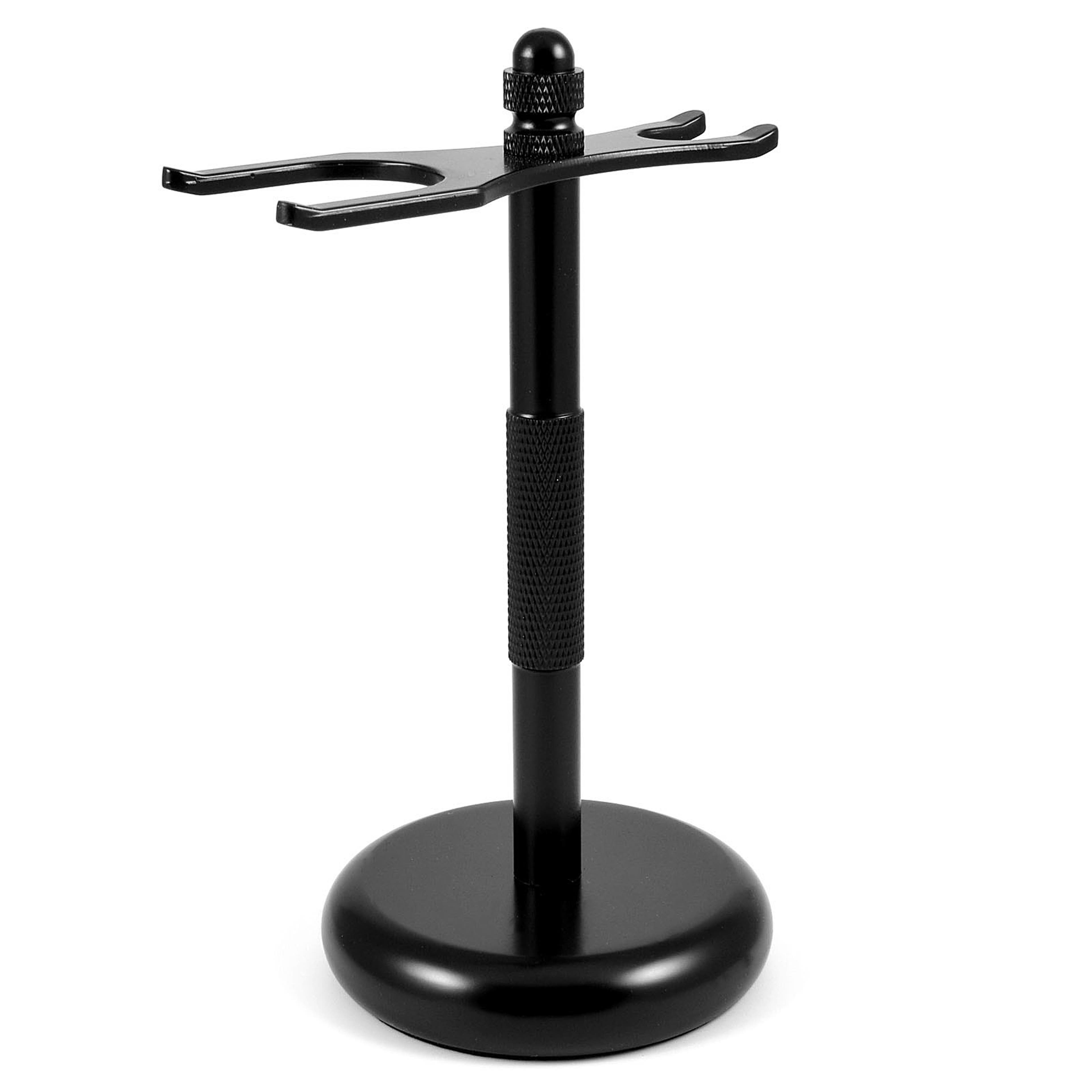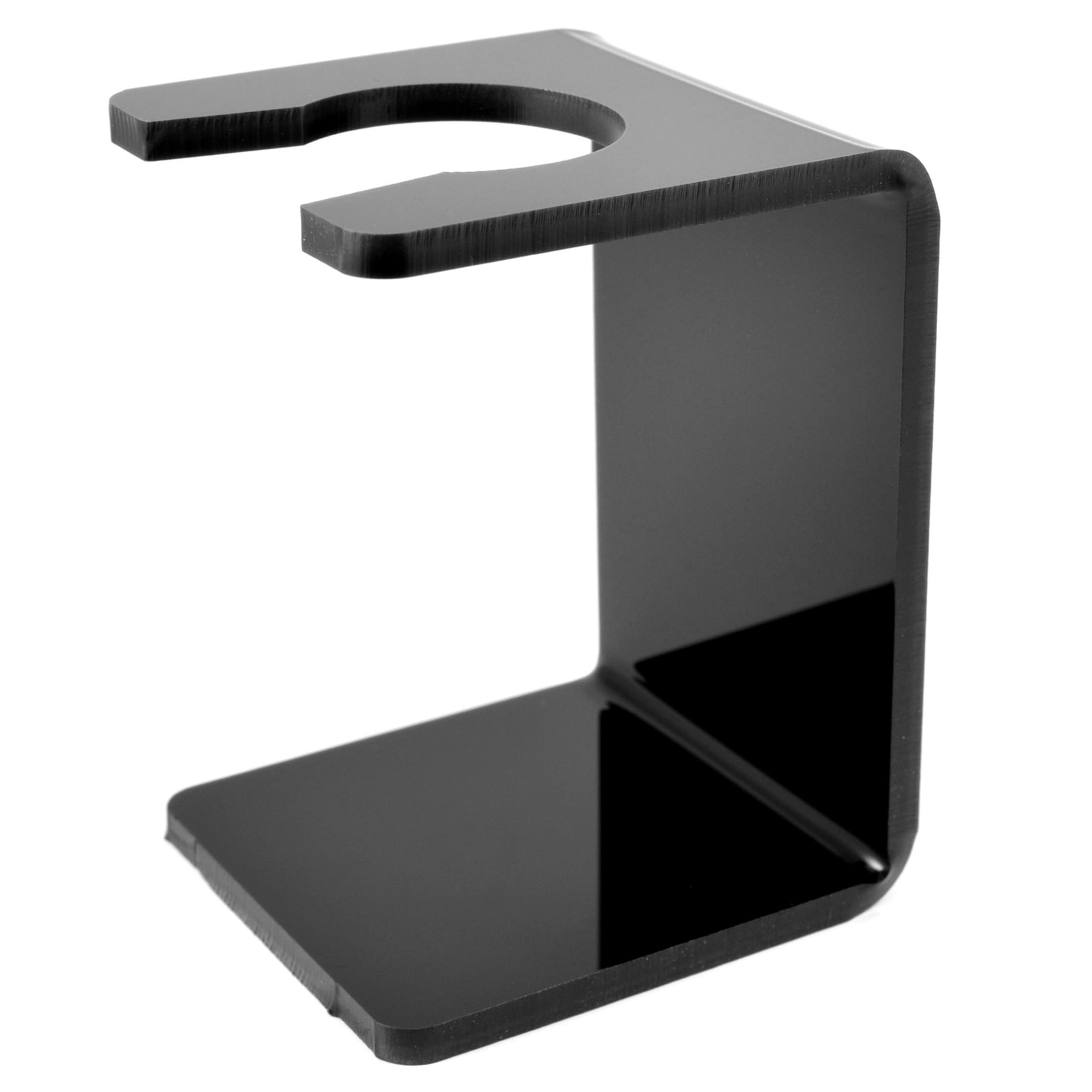Shaving Brush 101: Your Ultimate Guide to Shaving Brushes
Badger, boar, horse and synthetic. With so many choices on the market today, there’s no excuse for not getting the closest shave possible. Our comprehensive guide explains everything from selecting the right shaving brush to how to use it for maximum results.
Ever wondered what the purpose of a shaving brush is when you’ve got two perfectly good hands to apply shaving cream to your face? Well, you’re not alone. The right shaving brush in combination with some equally excellent shaving accessories (a rich lather) will change your life.
Maybe not your life. But it definitely changes your shaving experience for the better and refines your already stylish appearance.
What Is A Shaving Brush?
A shaving brush (or barber brush) is a small handheld brush used to apply shaving soap or cream to your face before shaving. Their design is made up of a handle, typically of metal, wood, horn or synthetic, and bristles of either natural or synthetic materials.
Shaving brushes are available in a variety of shapes, sizes and materials and are an essential part of a man’s grooming kit.
Must-Know Shaving Brush Anatomy
You’re bound to come across terms that refer to shaving brushes and shaving accessories that you’ve never heard before. Understanding what they mean is key to knowing what a shaving brush is and how to select the best one.
- Bristle
The hair or fibre that the brush is made from. Bristles can come from animals such as boars, horses and badgers, or be made from synthetic materials. Each type of bristle has pros and cons. - Loft
Loft refers to the length of the hair from the crown of the bristles to the top of the handle. The average loft for most shaving brushes is about 55 mm. - Height
Height takes into account the length of the handle plus the length of the loft to determine how tall the shaving brush is. - Base
The base is at the opposite end to the tip of the bristles. It is generally squared off so it can be placed flat and stand upright on a surface. Others are rounded so they can be held in a shaving brush holder or stand and easily stored facing downwards. - Knot
The knot is where all of the hair or bristles meet and are glued inside the base of the handle. The larger the knot, the firmer the brush feels against the face and the more water it retains.
- Lather
Lather is the most important factor in determining the quality of a shave. It is the end product once shaving cream or soap has been whipped into a rich foam. This foam, or lather, is then used to coat the face during shaving to provide protection and lubrication for the razor whilst also moisturising your skin. - Scrub or Scrubbiness
The scrub or scrubbiness of a brush is determined by the friction between your skin and the bristles. A brush with a powerful scrub generally has a stiff backbone and tight knot, and exfoliates your skin more effectively than a softer brush with a soft knot. - Water Retention
Water retention is important as it allows you to build a richer, more comprehensive lather. Without sufficient water being held in the bristles, you’ll never be able to create and hold a lather, making application of the lubricant a long and finicky process. - Backbone
Backbone relates to the stiffness of a brush’s knot. Conversely, backbone increases as the density of the hairs or fibres increase. The more backbone, the more scrubby your brush is and the better exfoliation it’ll provide. - Scuttle
The classic scuttle is essentially a purpose-built bowl that’s designed to hold your shaving cream or soap. Nowadays, scuttles are used as bowls in which to build lather. - Shaving Cream Warmer
No prizes for guessing what this is. A shaving cream warmer is a device that serves to warm up your shaving cream or soap. As opposed to a cold water shave, warm shaving cream or soap is ideal for opening pores, making for an easier, closer shave.
Why A Good Quality Shaving Brush Is Important
The best quality shaving brushes facilitate a fast and smooth shave. They’ll penetrate each and every hair and soften them at the same time. If you’ve got a well-rounded brush, dead skin cells will also be removed and your skin exfoliated – something fingers can’t do on their own.
A good quality shaving brush should create a rich lather, by whipping air into your shaving cream or soap. The lather protects and lubricates the skin, ready for a smooth shave. When done correctly, a desirable lather allows your razor to glide seamlessly across the area to be shaved, reducing irritation and delivering a supple finish.
Without the right shaving brush, you’ll never achieve a suitable lather, and without a suitable lather, you might as well try and shave with a wet shoe.
Different Types of Shaving or Barber Brushes
Scrolling through the multitude of shaving brush types available can leave your unshaven head spinning. We’ve broken down the most common shaving brushes and their benefits. Once you have a grasp on a brush’s strengths and weaknesses, you’ll be better equipped to purchase one to suit your preferences.
Boar Hair Shaving Brush
Boar hair brushes are stronger and do a good job of lifting the hair from the surface of the skin. This makes it easier to get the lather underneath each hair for a satisfying shaving experience.
Boar hair is generally a good place to start if you’ve never purchased or used a shaving brush before.
Pros
- Will soften over time
- Less expensive than badger hair
- Effective at lifting hair from the skin
Cons
- Can be uncomfortably stiff for the first few shaves
- Retains less water than badger hair
- Sheds bristles quicker than other brushes due to the brittle nature of boar’s hair
Horsehair Shaving Brush
Horsehair shaving brushes are only now coming back in fashion. And while they don’t hold as much water as some synthetic brushes or badger hair, they are more than adequate to use if you’re looking for a middle of the road shave.
Pros
- Softer than boar’s hair
Cons
- Retains less water than badger hair and some synthetics
- Can smell a bit on the nose during the first few uses (pet shampoo can help remove any unpleasant odours)
- Horsehair requires more care than badger hair, meaning it has to be properly cleaned and stored when not in use to prevent premature bristle loss
Synthetic Fibre Shaving Brush
Mid to low-grade synthetic brushes are frequently touted as being either too stiff or too floppy. The good thing is that the quality of synthetics is getting better as technology improves, meaning before long we may see faux hair brushes that can compete with the most reputable badger hair brushes.
Pros
- Ideal for those who are vegan or allergic to animal hair
- There’s a huge range of synthetic fibre brushes, from cheaper options to those that feel similar to badger’s hair
- Synthetic fibre brushes have been known to last a decent amount of time before breaking down
Cons
- Can feel rough on the skin even after multiple uses
- Cheaper brushes hold very little water, which equates to a poor lather
- Top-end synthetic brushes are still regarded as inferior to silvertip badger hair brushes
Badger Hair Shaving Brushes
Badger hair shaving brushes are the best type you can buy, hands down. Soft and durable, badger hair is regarded by barbers around the world as the creme de la creme when it comes to performance and appearance.
Badger hair brushes can last for years if cared for properly.
Pros
- Available in a pure, best, (fine) super or silvertip brush type, with the latter being top of the line
- Absorbs water better than any other type of animal hair or synthetic fibre
- Less coarse on the skin
- Badger hair is incredibly fine, meaning each brush has a high density of bristles that contribute towards a richer lather
Cons
- Can be hard to find an authentic badger hair brush with so many cheap imitations flooding the market
- Badger hair brushes have a reputation for being expensive, which means they’re probably not suited to first-time users
Which Badger Hair Brush Is Best?
Pure Badger Hair
Pure badger hair brushes are the most readily available and least expensive out of all types of badger hair brushes. Hair for these brushes is made from the hair that covers roughly 60% of the badger's body. It includes the neck, shoulders, buttocks, abdomen, etc.
One of the benefits of using a pure badger hair brush is its ability to scrub and exfoliate your skin, thanks in part to the coarseness of the hair that is used.
- Colours range from dark tan to jet black
- Hairs are taken from the neck, shoulders, abdomen and buttocks
- Typically seen as an entry-level brush
Best Badger Hair
Best badger hair brushes are a step up from pure hair. The hair for this type of brush is taken from the belly of the badger, where the hairs are longer, more pliable and finer. This means that best badger hair brushes retain water more effectively than pure hair, which in turn makes it easier to whip up a richer lather.
- Colours range from light brown to grey
- Hairs are extracted from the belly and other broad surfaced areas of the badger
- Regarded as a great value option when considering performance versus cost
(Fine) Super Badger Hair
Super badger hair comes from the dorsal regions (the back) of the badger and is much harder to come by than pure or best. It is softer than best badger hair but not as cushiony (or expensive) as silvertip. Super badger hair is often mistaken or simply lumped in with silvertip badger hair since the differences between the two are subtle.
The one drawback to super badger hair brushes is the amount of upkeep required to keep their delicate hairs in tip-top working order. This means you’ll have to ensure you look after them to get your money’s worth.
- Hairs are taken from the upper sides of the badger
- The colour spectrum runs from mottled white to a light grey centre and then white tips
- Expensive, rare and nearly indistinguishable in regards to performance when compared with silvertip badger hair brushes
Silvertip Badger Hair
Found in the neck area of badgers, silvertip hairs are used to make the most luxurious brushes around the world – silvertip badger shaving brushes. Their reputation as the best of the best is due to the fact silvertip brushes deliver the most cushiony type of shave and hold more water than fine brushes. Their cost is relative to the fact that a silvertip brush will last for years if it’s cared for.
To shave with a silvertip brush is an experience unto itself. More of a massage for your face, a silvertip will facilitate the gentle yet penetrating application of lather that can then be spread delicately across the face. One could say that once you go silvertip badger hair, you’ll never go back.
- Touted as being at the top of the shaving brush chain in regards to quality
- Hairs for a silvertip badger brush are extracted from the neck or cervical area of the animal
- The colours of this brush encompass a cream-white base with a jet black band and silver tips, hence the name
Shaving Brush Handles
A shaving brush handle should fit snugly in your hand and offer adequate grip during the lather and application process. But let’s be honest, who doesn’t want a shaving brush handle crafted from polished timber or bison bone? Or, what about a handle made from chrome, brass, nickel, aluminium or synthetic materials?
Heaviness and shape come into play when looking for the perfect shaving brush. Too much weight and it may feel more like a doorknob. Too little and it’ll feel flimsy. You ultimately want something that gives the maximum amount of control to get in and around those hard to reach hairs on your face and neck.
The best way to figure out if a shaving brush is right for you is to simply pick it up. Whatever your decision, note that a shaving brush is only as good as its bristles.

How To Know If You’ve Chosen The Right Shaving Brush
How do you know what a good shaving brush feels like if you’ve never used one? Upon trying a shaving brush for the first time, it’s important to consider the following factors.
Does It Have A Suitable Backbone? Backbone, or flex as it’s sometimes called, refers to the stiffness attributed to the knot of the shaving brush. The amount of backbone a shaving brush has is proportional to how stiff it is and how it performs when pumping and swirling to create a lather. Scrubbiness in a brush occurs with a stiffer knot, while flex is seen as being a result of a soft knot.
Does It Shed Bristles With Every Use? A few hairs left on your skin or in the sink over the course of a month or so is nothing to be alarmed about with a lower grade boar or synthetic brush. Shedding is to be expected further down the track. For a good quality horse, synthetic or badger hair brush however, hairs should remain pliable and hold their shape for years.
Has It Been Ethically Produced? Another point to ruminate on is if the shaving brush in question has been ethically produced? While this may not have been a consideration for our fathers and grandfathers, there’s no excuse in the modern age for shaving or barber brushes to be made using anything but sustainable practices.
How Does It Feel In Your Hand? Does it have that telltale heaviness to it, indicative of a good quality brush? Or does the handle feel cheap and the bristles, prickly and sparse once applied to the skin. Sometimes, the only way to tell if you’ve selected the right shaving brush is to just pick it up and give it a try.
Did The Brush Promote A Clean, Close And Comfortable Shave? Last but not least, how did your shave feel and can you see the difference between simply applying lather using your hands or using the brush? The latter technique can stick hairs to your face, while a shaving brush lifts facial fuzz for a more efficient cut, while at the same time exfoliating your skin. It should hold moisture and comprehensively cover the entire area you’d like to shave with ease.
How To Use Your Shaving Brush
Time to channel your inner Karate Kid, except this time it’s not, ‘wax on, wax off’, but ‘lather on, lather off’. Before putting your shaving tools to work, we recommend dabbing your face with a warm towel to open up any pores. Conversely, you can shave straight after the shower which is generally much easier, as warm steam naturally relaxes your skin.
Grab your shaving brush and mug, bowl or scuttle and check out our step-by-step guide on how to use a shaving brush for a wet shave below.
You’ll want to first get a shallow shaving scuttle or bowl of cream or soap ready. This will be used in tandem with your brush to create the lather.
- Take your brush by the handle and wet it with warm water, then gently shake off any excess. You can also let it soak in the bowl with warm water. Use warm water – not hot.
- Dip the brush lightly into the bowl of shaving cream or soap and whip into a rich, foamy lather.
- Check that the lather is the consistency you’re after. A good lather is key to a close shave.
- Bring the brush to your face and slowly move it in a circular motion, making sure to cover all areas of your beard or stubble.
- After shaving, rinse the brush with warm water to remove soap or cream.
- Squeeze and gently shake off excess water before storing your brush (bristles down) in a stand.
Caring for Your Shaving Brush
- After shaving, rinse the brush under warm water (never boiling) to ensure all lather has been removed
- Place the brush in a shaving brush stand so that the bristles are pointing downwards. This draws moisture away from the base and promotes drying
- Make sure your shaving brush holder is placed in a dry area and not in a cupboard or in a bag to prevent mildew
- Rinse the shaving scuttle or bowl and ensure all residual foam has been wiped away
- Never pull or tug at the bristles or attempt to dry your brush or shaving scuttle in front of a heater or with a blow dryer
- Leave your shaving brush in the stand to air out
Giving Your Shaving Brush A “Spring Clean”
No matter how careful you are cleaning, drying and storing your brush, there’s a good chance it’ll still begin to look a little haggard after a few months of daily usage. Instead of putting up an unsightly and underperforming brush or discarding it for a new one, there are a few treatments you can try that may help restore it to its former glory.
Shampoo Simply add a dab of mild shampoo (or pet shampoo) to the dish, bowl or scuttle where you normally create your lather, then use the brush after it’s been run under warm water to whip the shampoo into a foam.
Afterwards, massage shampoo into the brush head with your hand, paying close attention not to distress the bristles. Rinse with cold water making sure all suds have been removed, then add more shampoo to your brush and repeat the process, making sure to rinse it thoroughly once finished.
A final shake and flick of the brush plus a gentle comb will complete the clean and straighten out any frayed hair. Conditioner can be added as an added step in the process.
You Asked – We Answered
Why should I use a shaving brush?
Using a shaving brush is the most efficient and effective way to lift the hair from your skin and apply shaving cream or soap to all areas that you intend to shave.
Not only do they deliver a smoother shave; they exfoliate, moisturise and lubricate your skin, plus they require less cream or soap than if you were using your hands.
How do I know if my shaving brush is right for me?
The best way to tell if a shaving brush is right for you is to review its performance one month after its first use. By then bristles will have softened, but they should still hold their shape when the brush is stood upright on a flat surface.
The brush itself should feel soft and comfortable on your skin and leave the shaved surface smooth and rash free.
How long does a shaving brush typically last?
Most cheaper shaving brushes for example (horsehair, low-grade synthetic and boar hair) will last anywhere from a few months to a couple of years if they’re cleaned, left to dry and stored correctly. Premium badger or synthetic bristle brushes given a similar treatment will perform as intended for 3 to 10 years or even longer.
Caring for your brush is the X factor that determines how long it will be around for. Creating and applying lather without too much force can help extend their lifespan, as can cleaning them with mild shampoo when necessary.
My brush is shedding hair – is that normal?
If your brush is losing bristles at an alarming rate or you require lots of lather and multiple shaves to get in underneath every hair, try switching it up for one made from a different hair.
Slight shedding during the first two weeks of usage isn’t such a big deal, but if clumps of hair fall out, you’ve got an issue. Remember that caring for your brush is essential in ensuring it doesn’t shed an unusual amount of bristles. Never twist it or wash it too vigorously and always leave it to dry after it has been rinsed. If long hairs are coming out with glue attached to their end, that’s a telltale sign that your brush is not far from retirement.
Should I use a shaving brush with foam or soap?
Whether or not you should use a shaving brush with foam or soap depends on personal preference. We suggest experimenting with both to see how your skin reacts. More importantly, you’ll want to ensure the foam or soap in question can be whipped into a rich lather. If, after multiple attempts, you can’t produce a thick enough cream, consider trying the alternative.
How do I get the most usage out of my shaving brush?
To get the maximum amount of mileage out of your brush, you’ll want to ensure you’re cleaning, drying and storing it correctly.
Make sure you only use warm (not boiling) water post-shave to clean it, then put it on a stand – bristles down – and leave it to dry by itself. Never store it in damp areas e.g. in a toiletries bag or cupboard.
What is the best type of shaving brush for the stylish modern man?
The best type of shaving brush for the stylish modern man depends on one thing… just how stylish you are! If you’re looking for top-of-the-line, the best type of shaving brush is undoubtedly a silvertip badger brush. If you want a brush that’s going to offer the best value for money, go for a horsehair brush.
What is the difference between a bulb and a fan-shaped shaving brush
In theory, the difference between a bulb and a fan-shaped brush is in how much area they cover.
Bulb shaped brushes are often smaller but can deliver better precision when applying the lather, thanks to the way that the bristles taper off to a rounded crown. Fan-shaped brushes are designed to splay out and cover a larger surface.
Is there such a thing as a travel shaving brush?
Yes! Travel shaving brushes are much smaller than your average sized brush, and a few even have vented cases and holes in the top or bottom to facilitate fast drying. Some travel brushes even allow you to pull the bristled section out so you can turn it around and store it back in the handle.
How can I size a shaving brush?
For most people, dimensions come down to personal taste. If you prefer to cover a larger area then by all means, choose a larger brush. A smaller one will do the same job.
Can you use a shaving brush with shaving foam?
Yes, you can use a shaving brush with shaving foam. However, if you want to wet shave like a pro, you’ll need to forgo using it.
If you’re on the hunt for wet shaving supplies, just remember both gel and foam should be avoided if possible due to the massive amount of harmful chemicals and mineral oils that reside in the cans.
Cream is undoubtedly the best way to achieve a consistent lather plus its moisturising properties mean your skin feels silky smooth once you’re finished. Shaving soap can be used, but you may find the many types on offer daunting. From triple-milled to hard soaps, semi-hard soaps and even something called croaps (cream soaps), the ideal soap for you comes down to price and personal choice.
How do I break in a shaving brush?
Breaking in a shaving brush is the only way to get rid of that very distinct and often unpleasant odour that a new brush emits. It’s necessary to ensure that your brush performs to its potential. To break in a shaving brush, you’ll first need to give it a brisk wash with dish soap.
Afterwards, allow it to soak in said soap and warm water for about 10 to 15 minutes, making sure the handle is kept upright and dry. Lastly, you’ll need to build a lather, using the brush then set it aside keeping the lather on the bristles. Then, leave it to sit overnight. The next day all that’s required is for you to rinse it under warm water and let it dry.
The aim here is to introduce moisture from water and the lather to soften the bristles and prep them for future usage. Please note that it may take a couple of weeks for a brush to feel like it’s working correctly, so give it some time. The aforementioned steps are simply a way to speed up the process.

